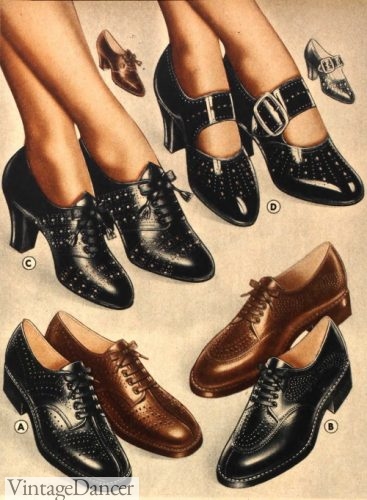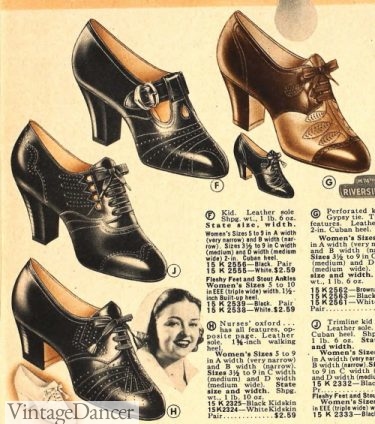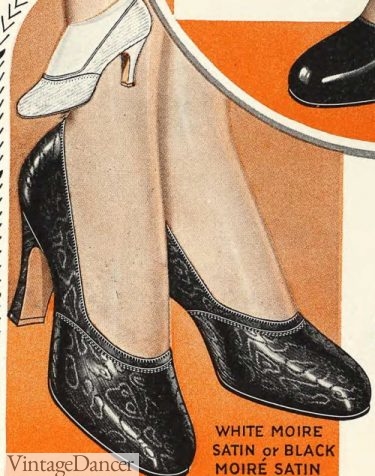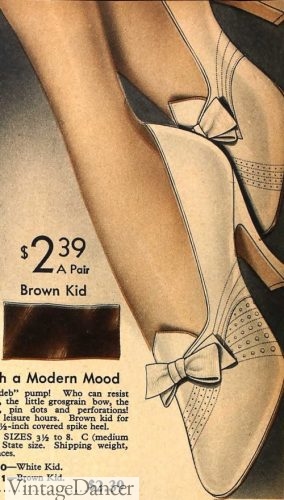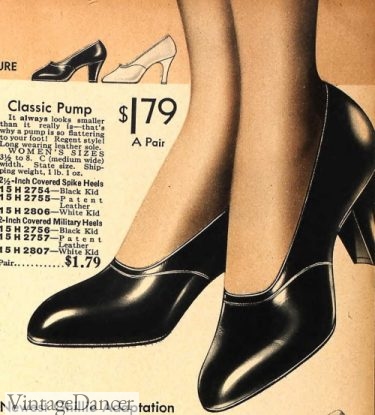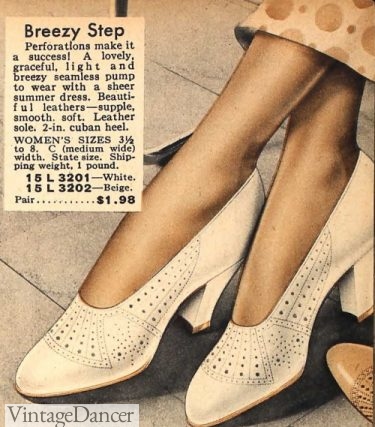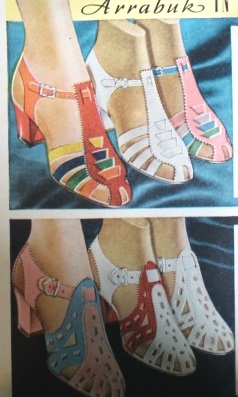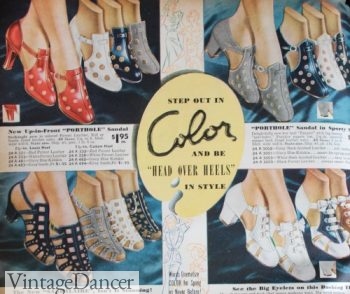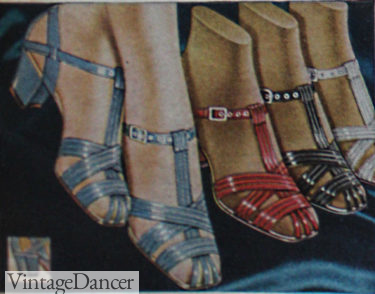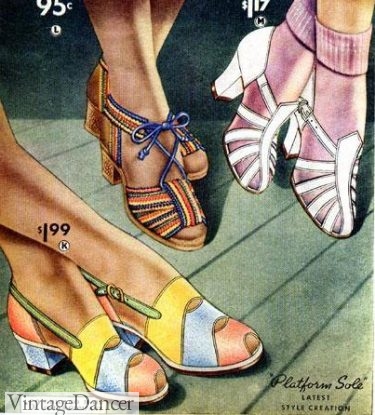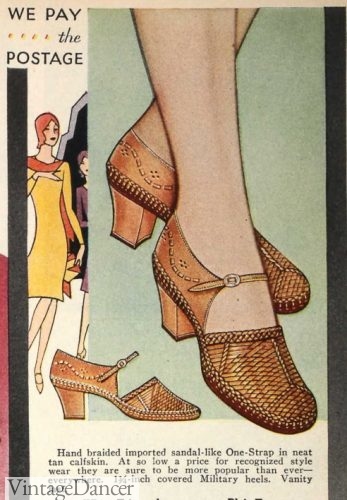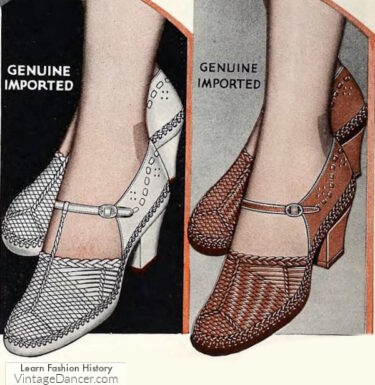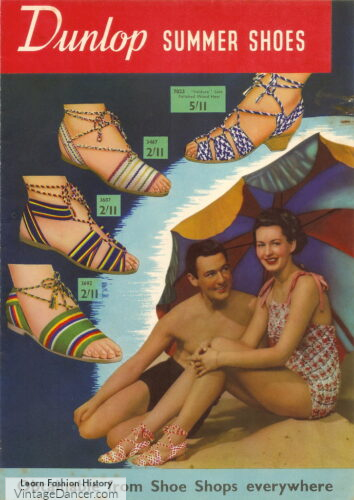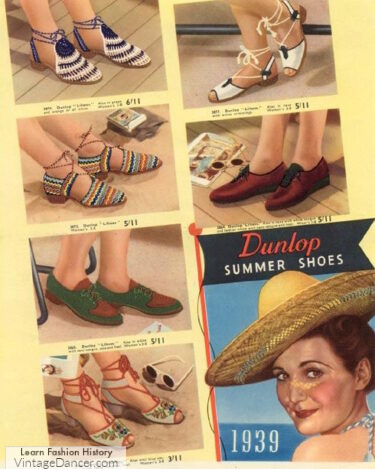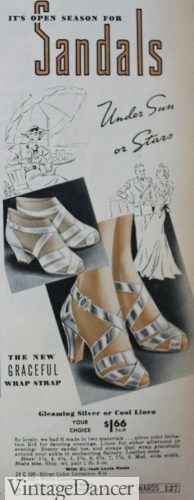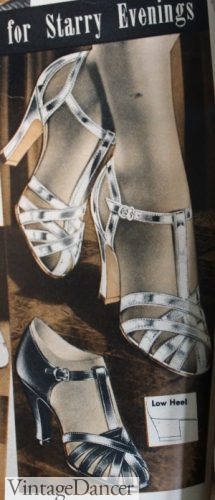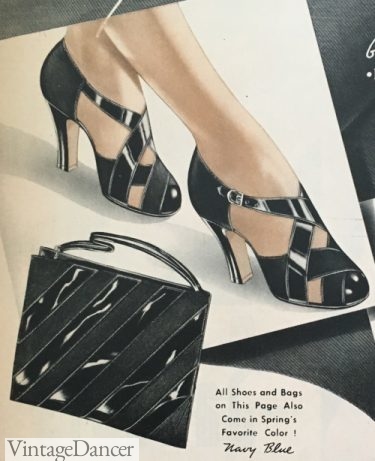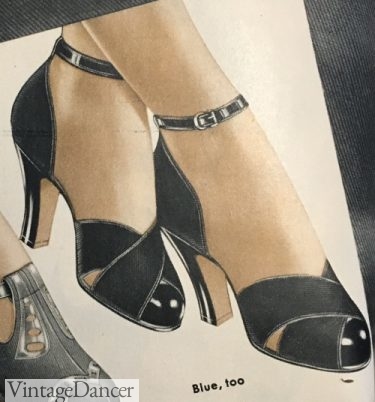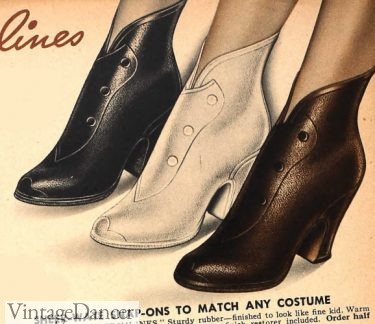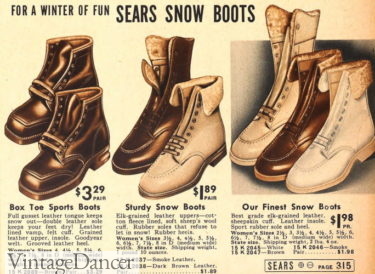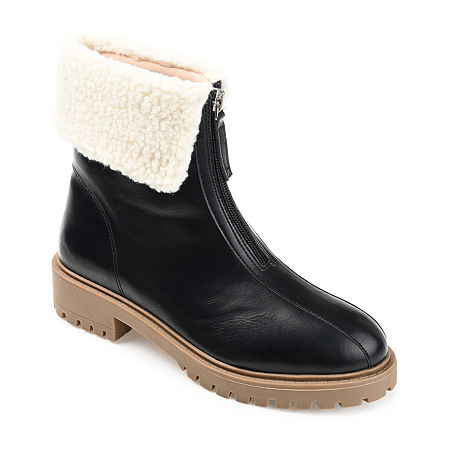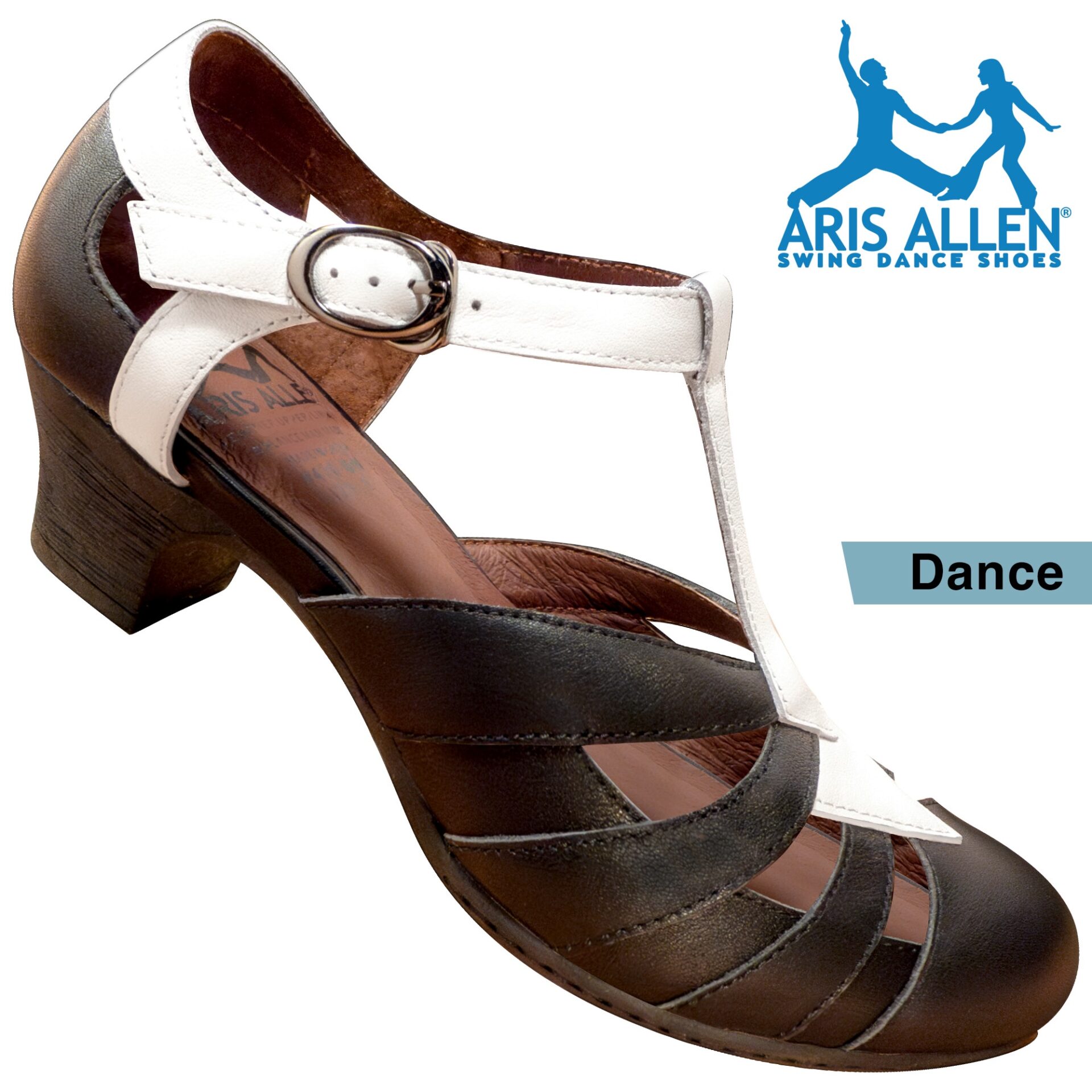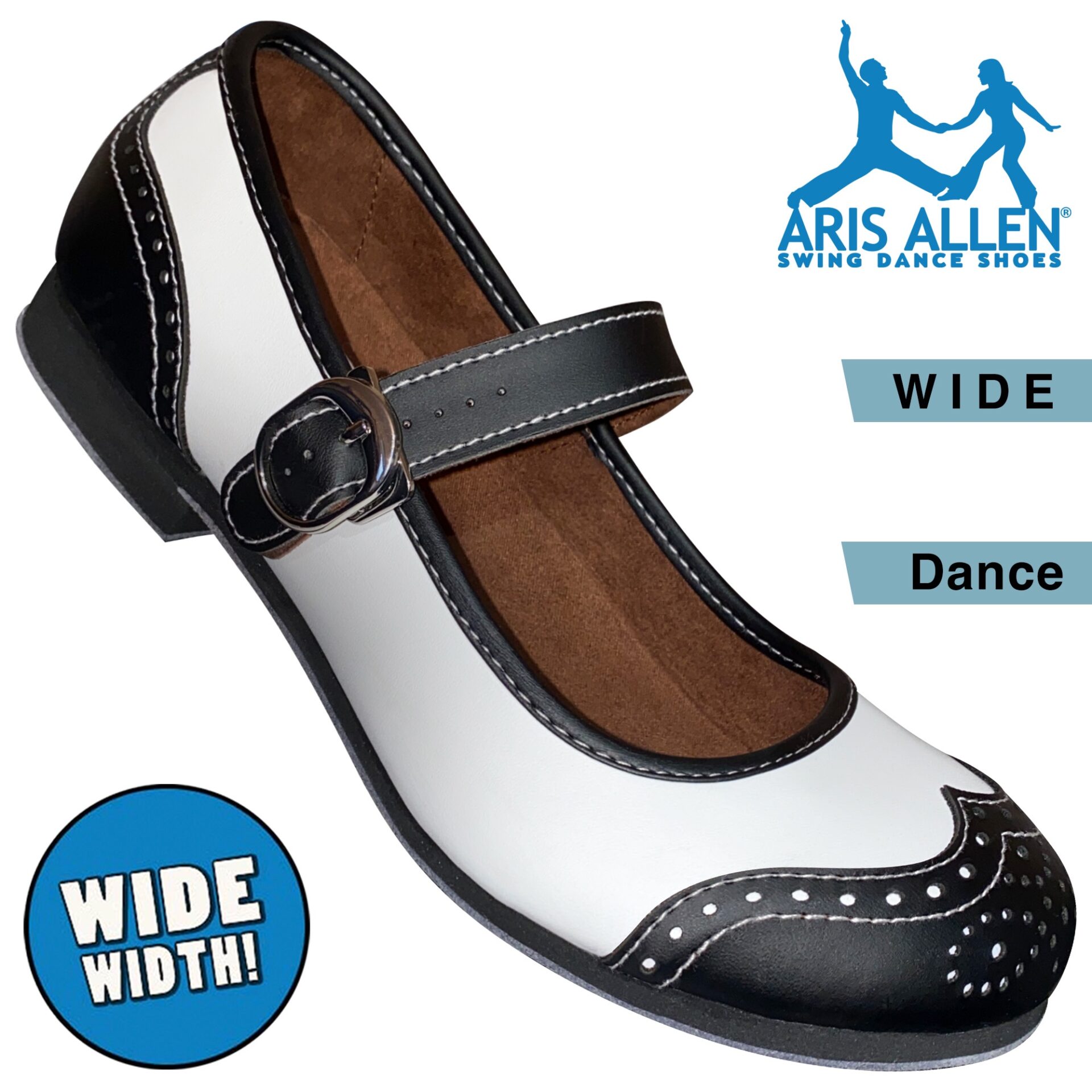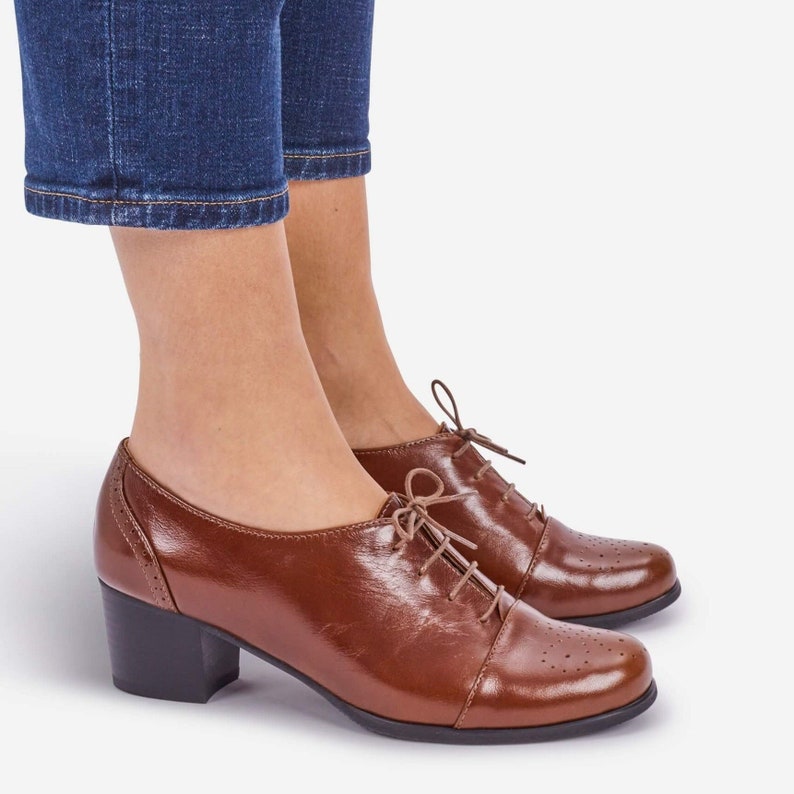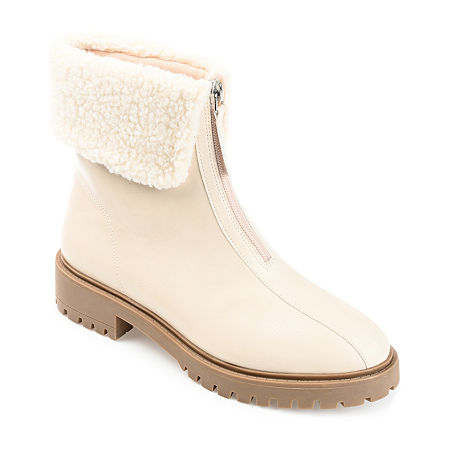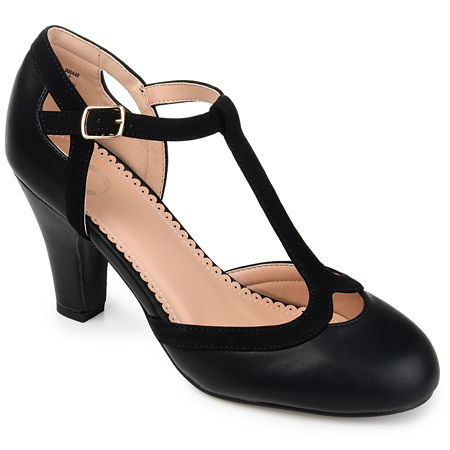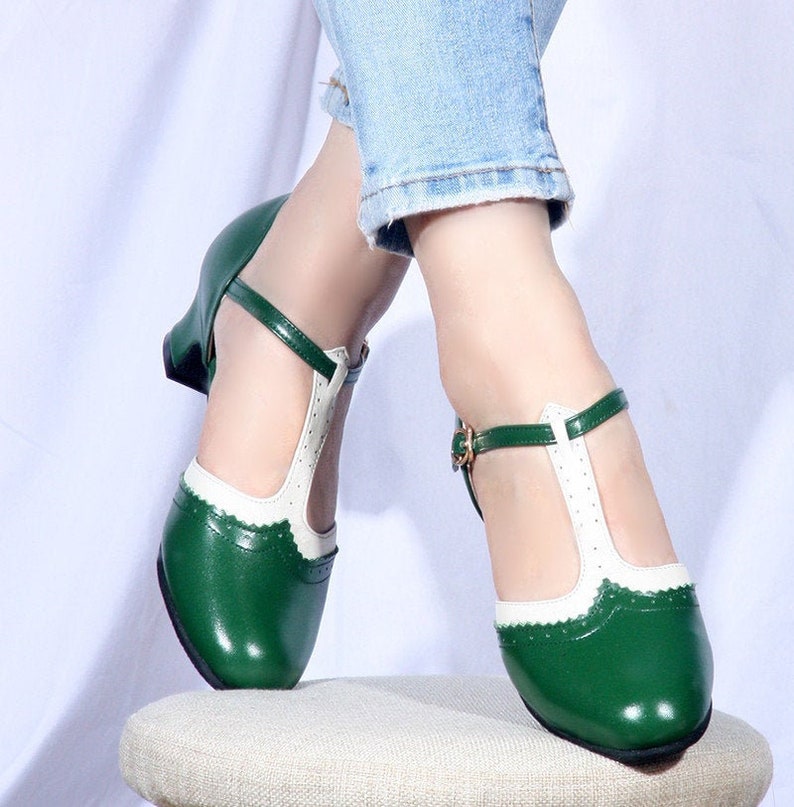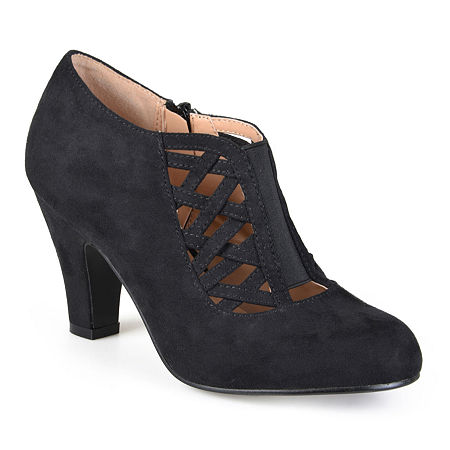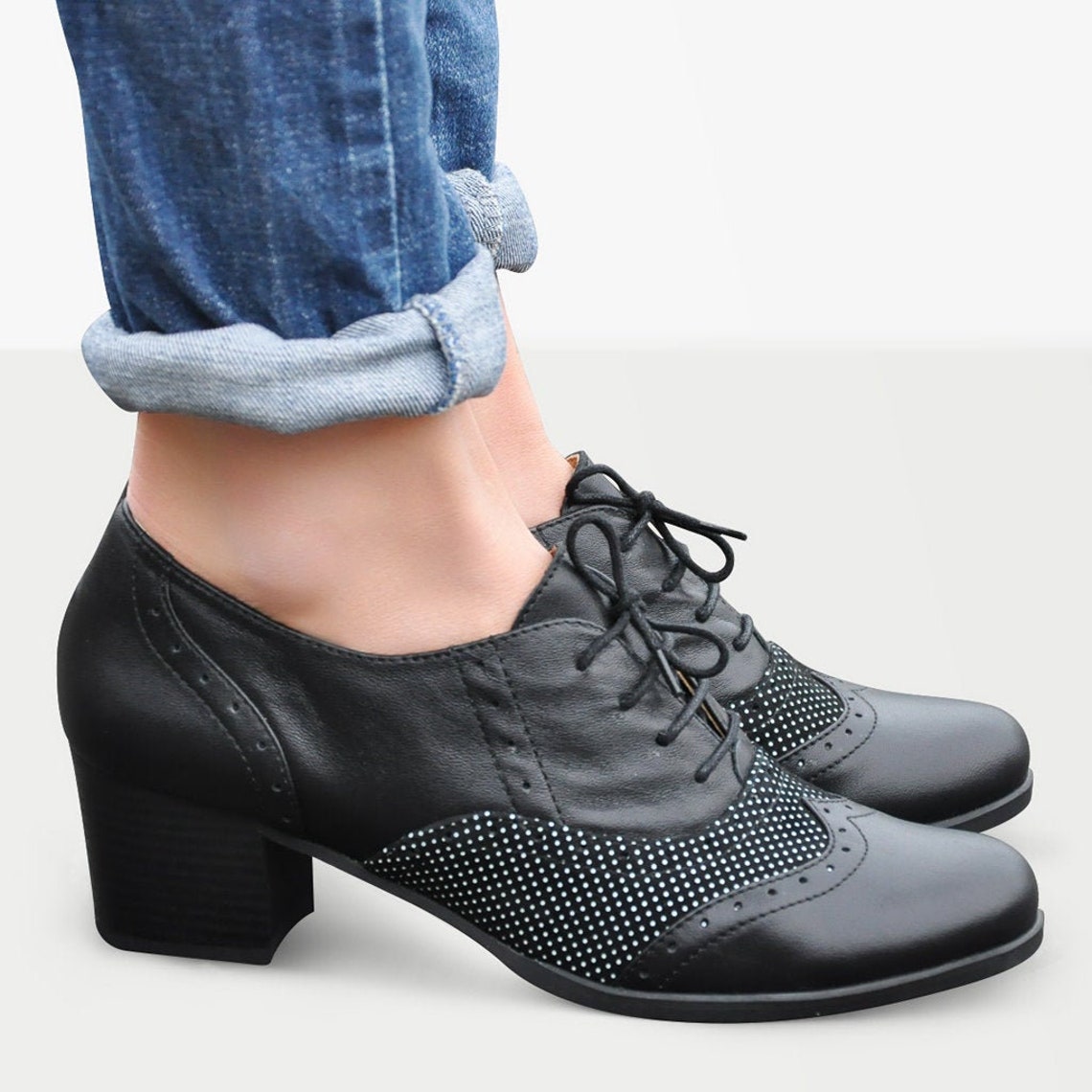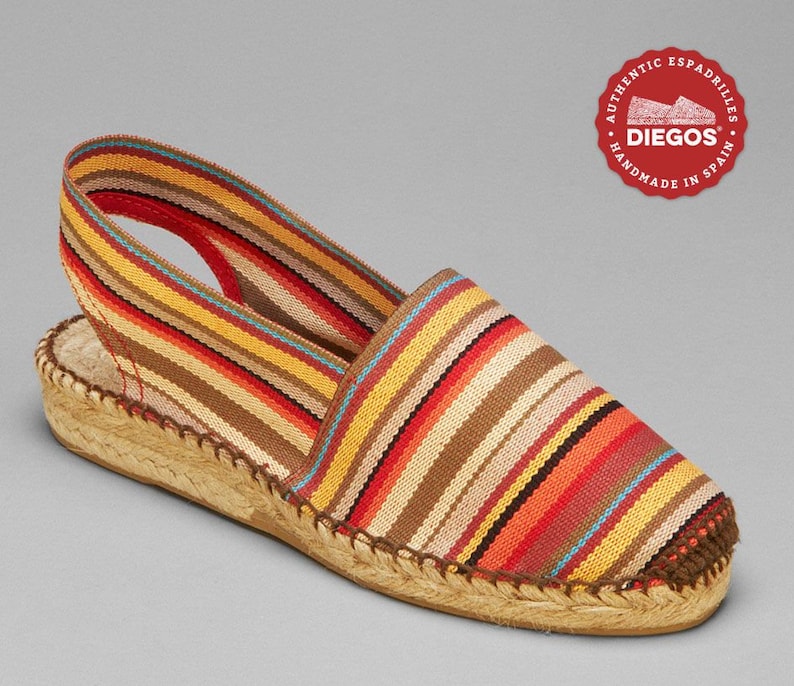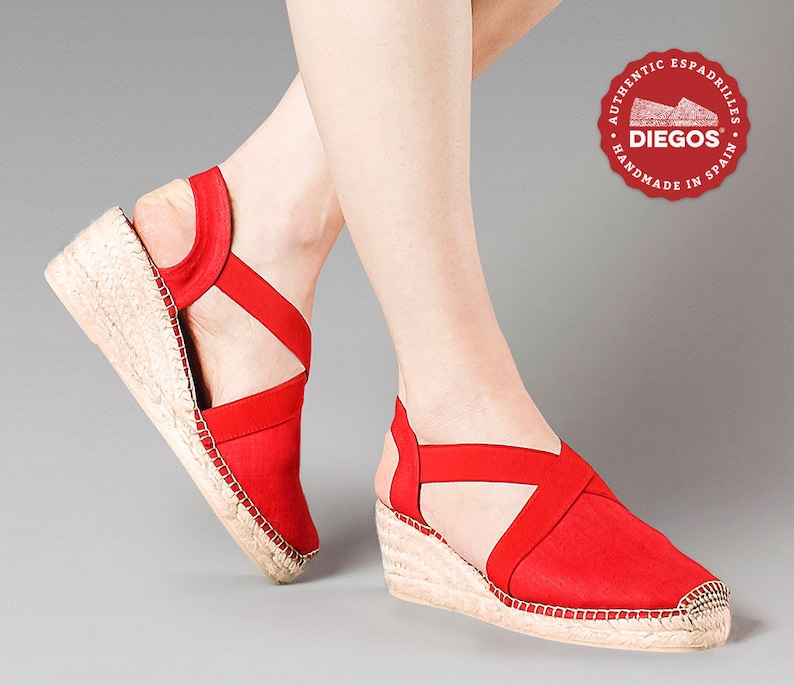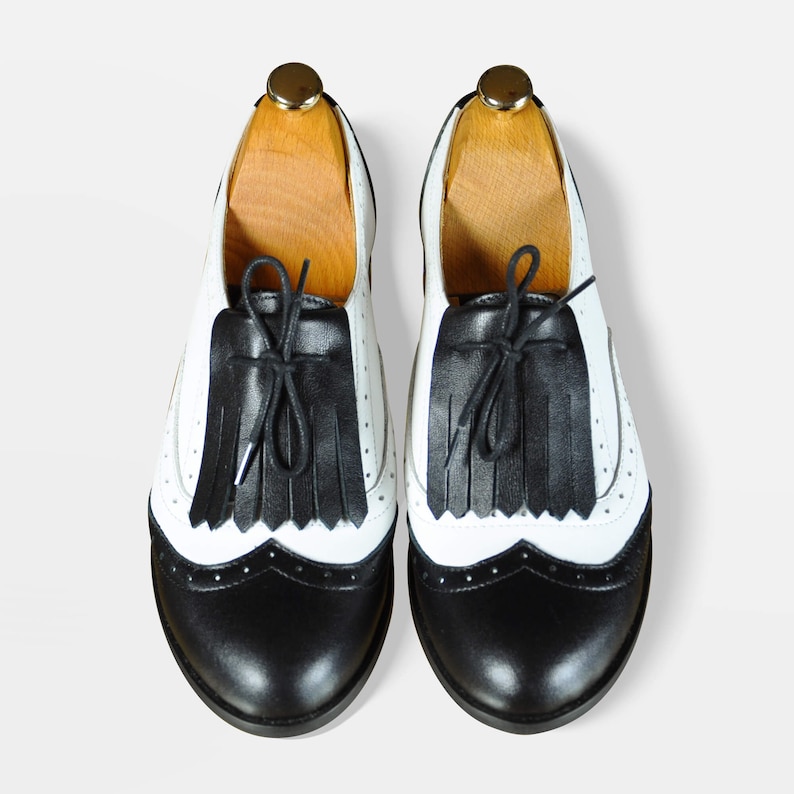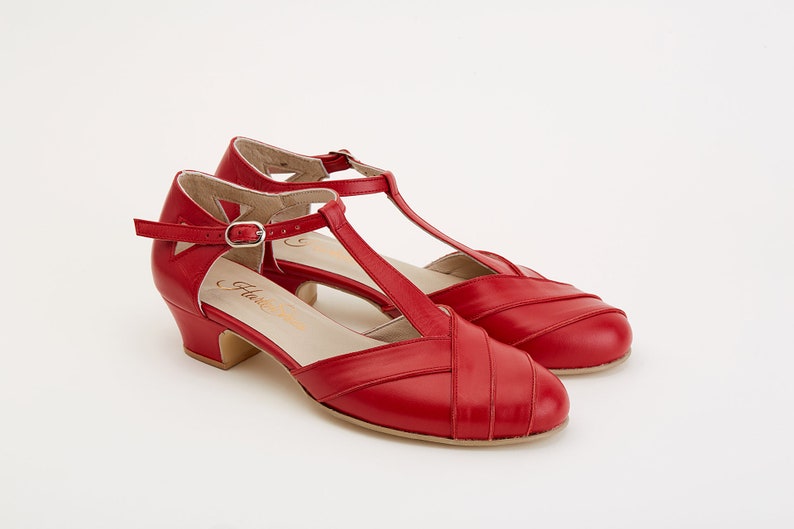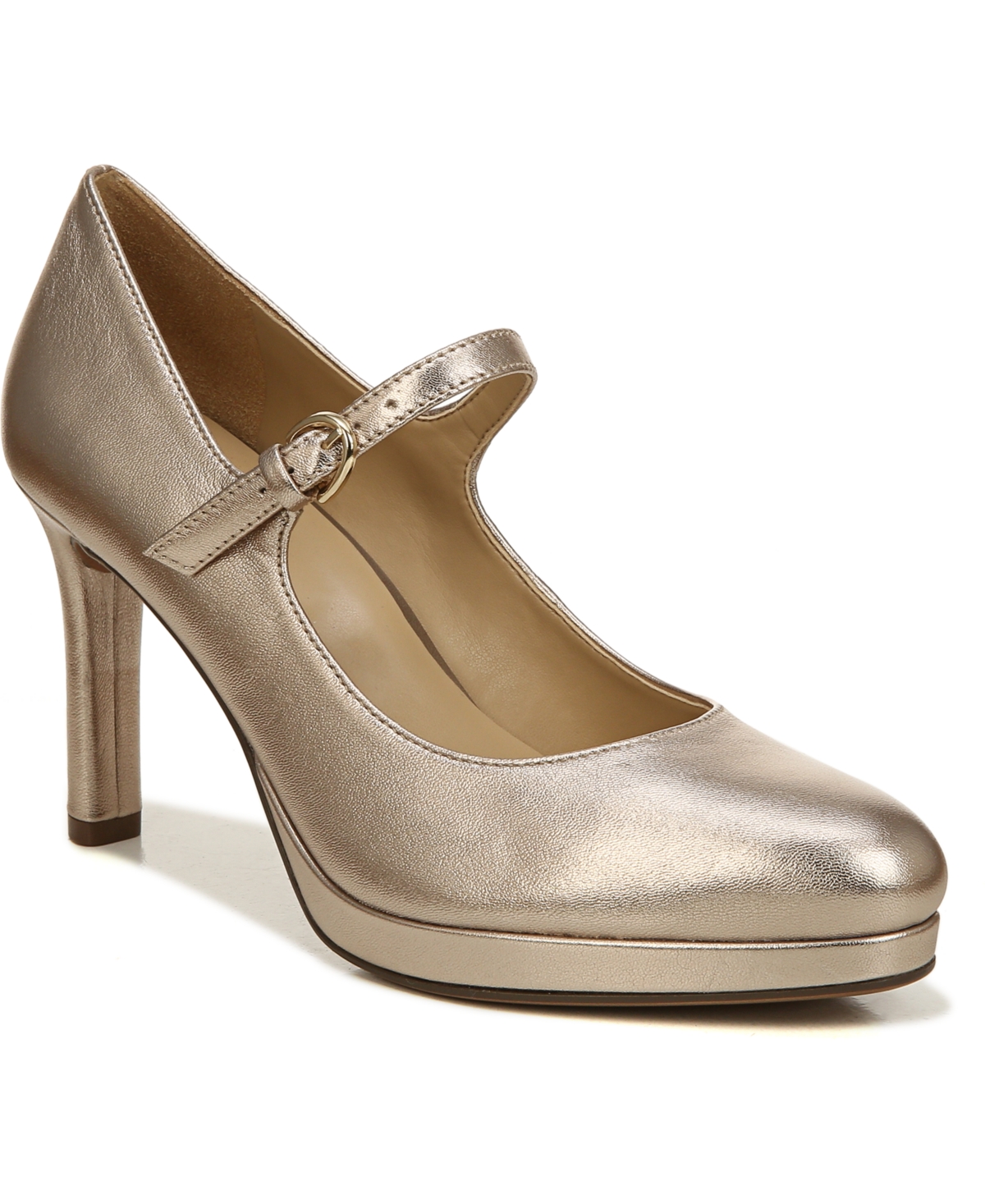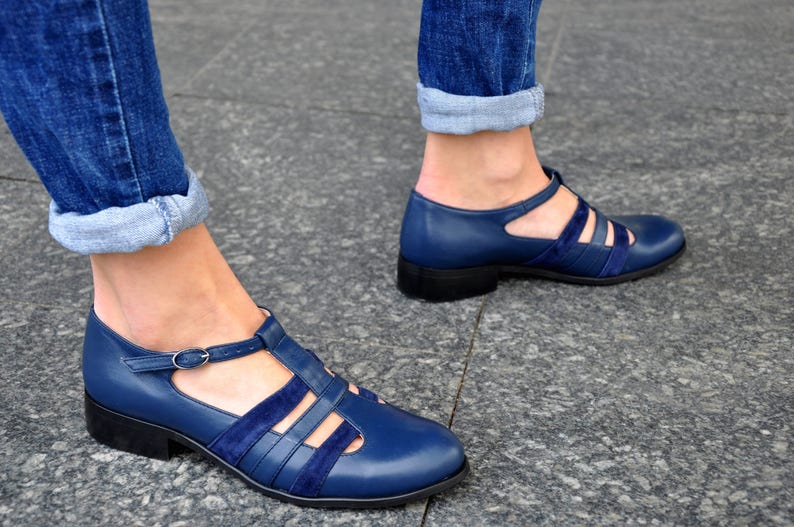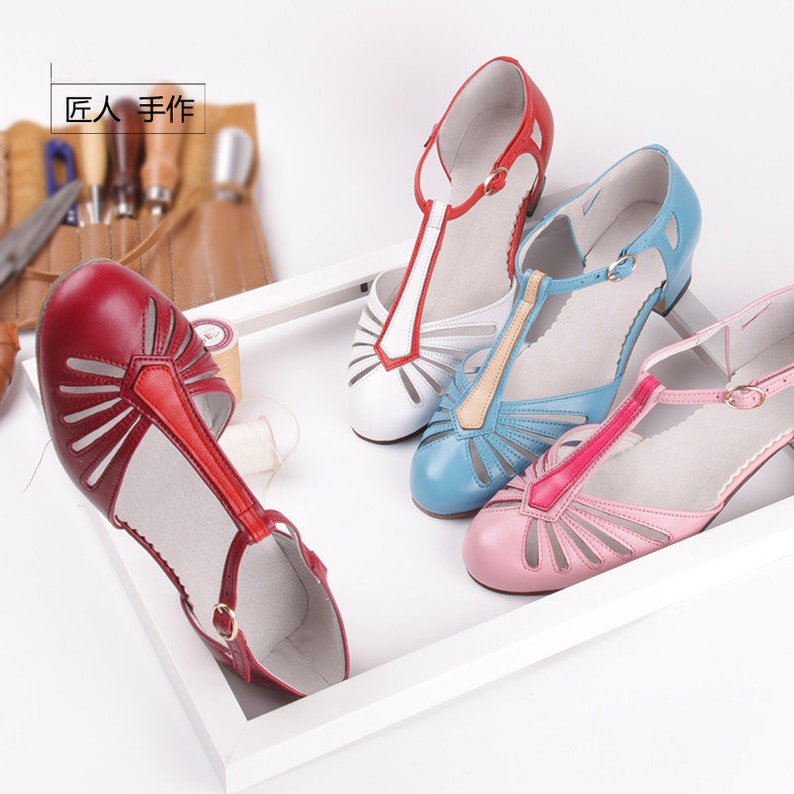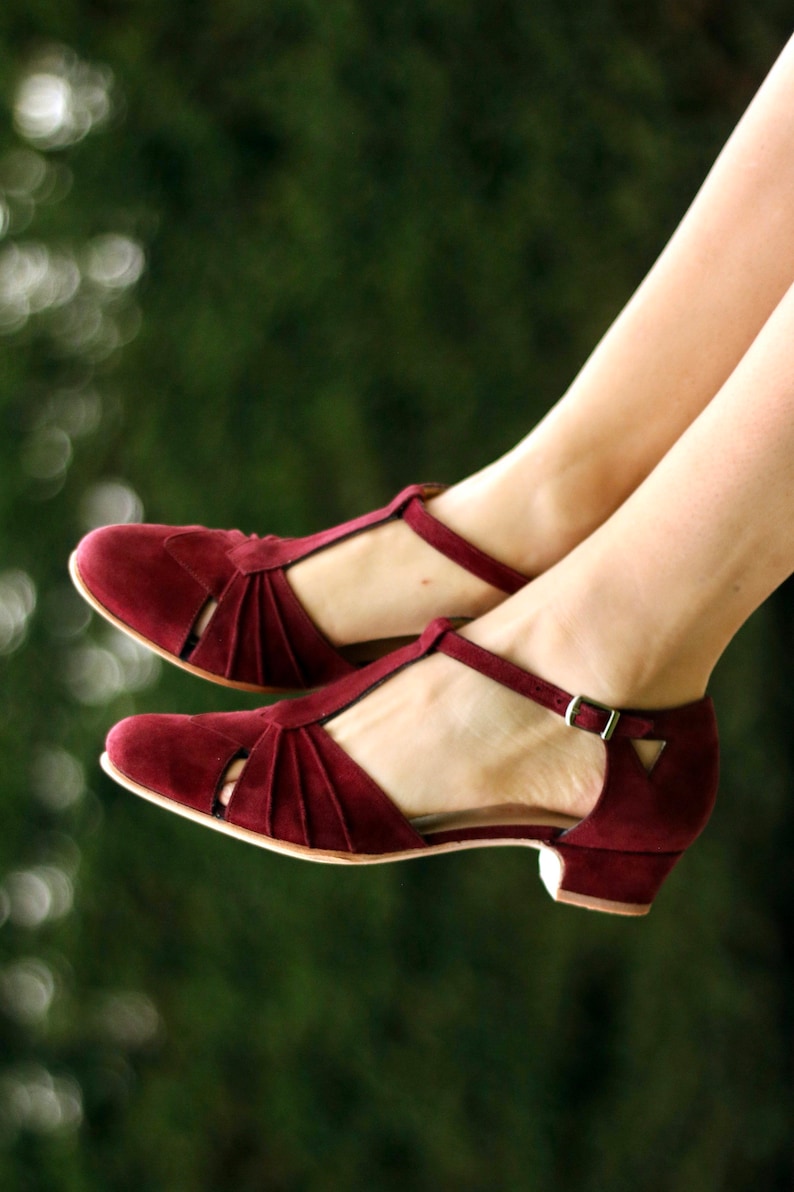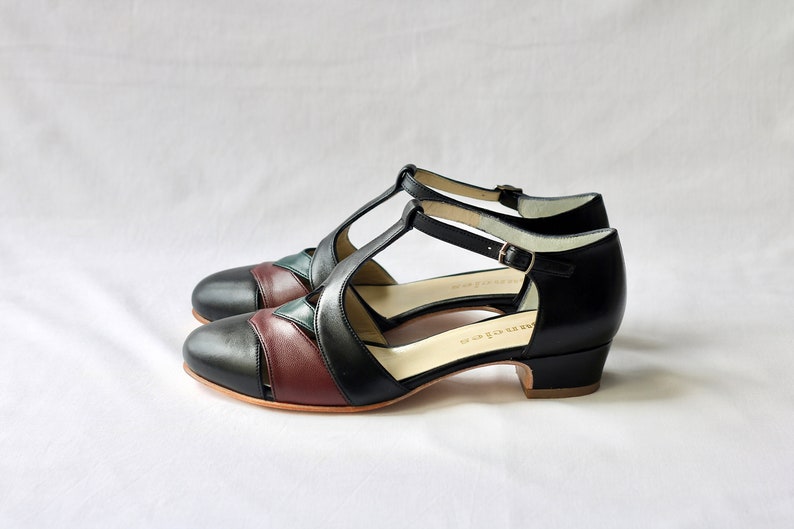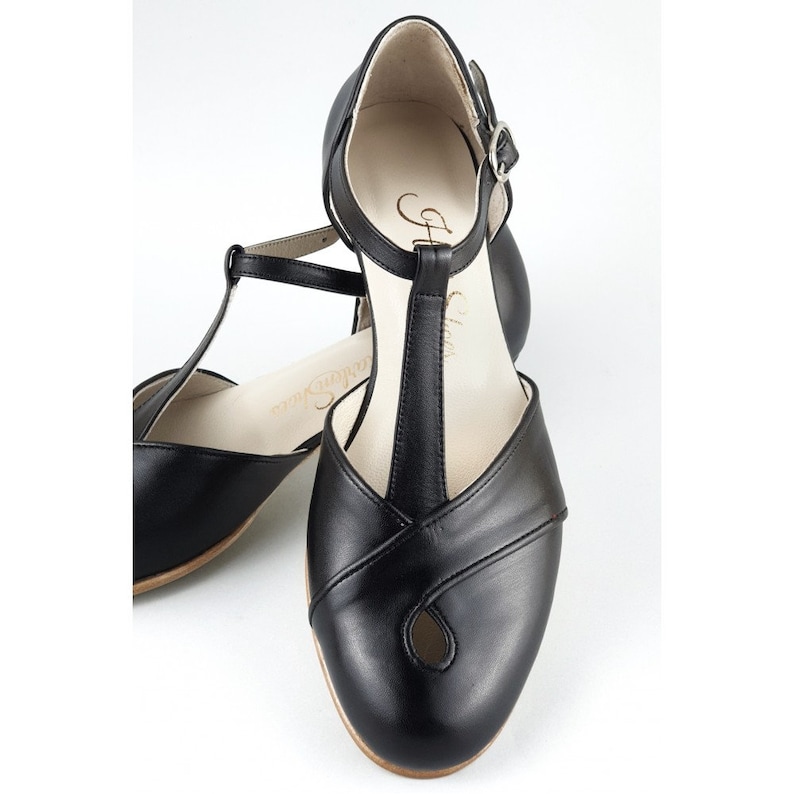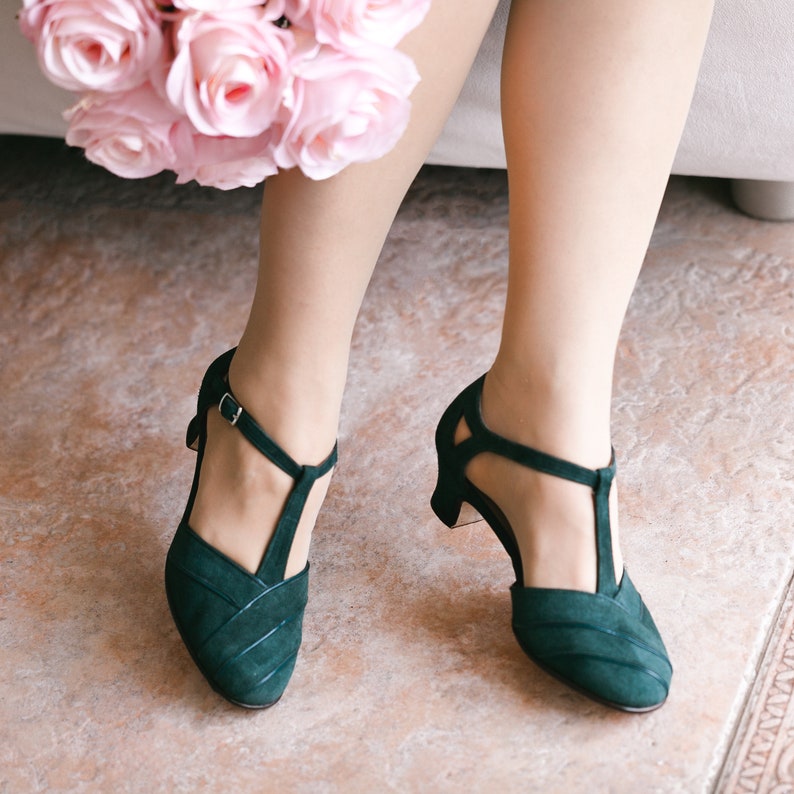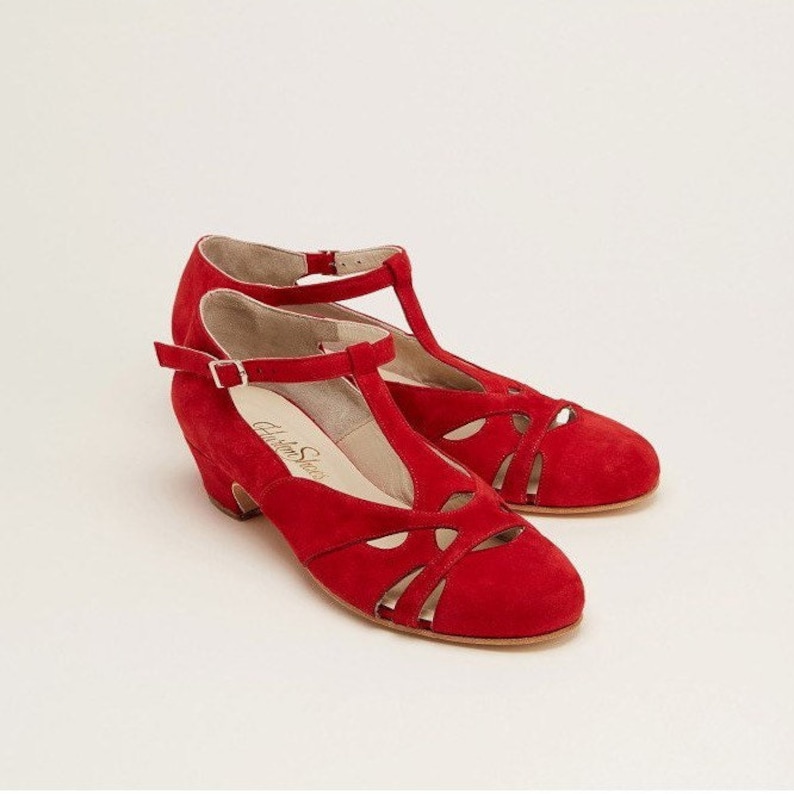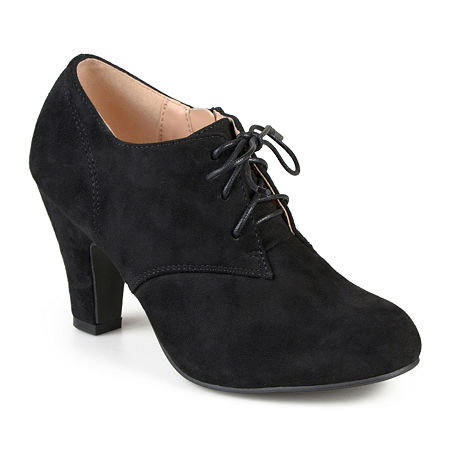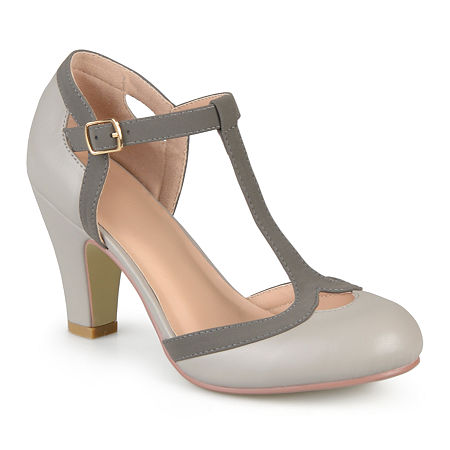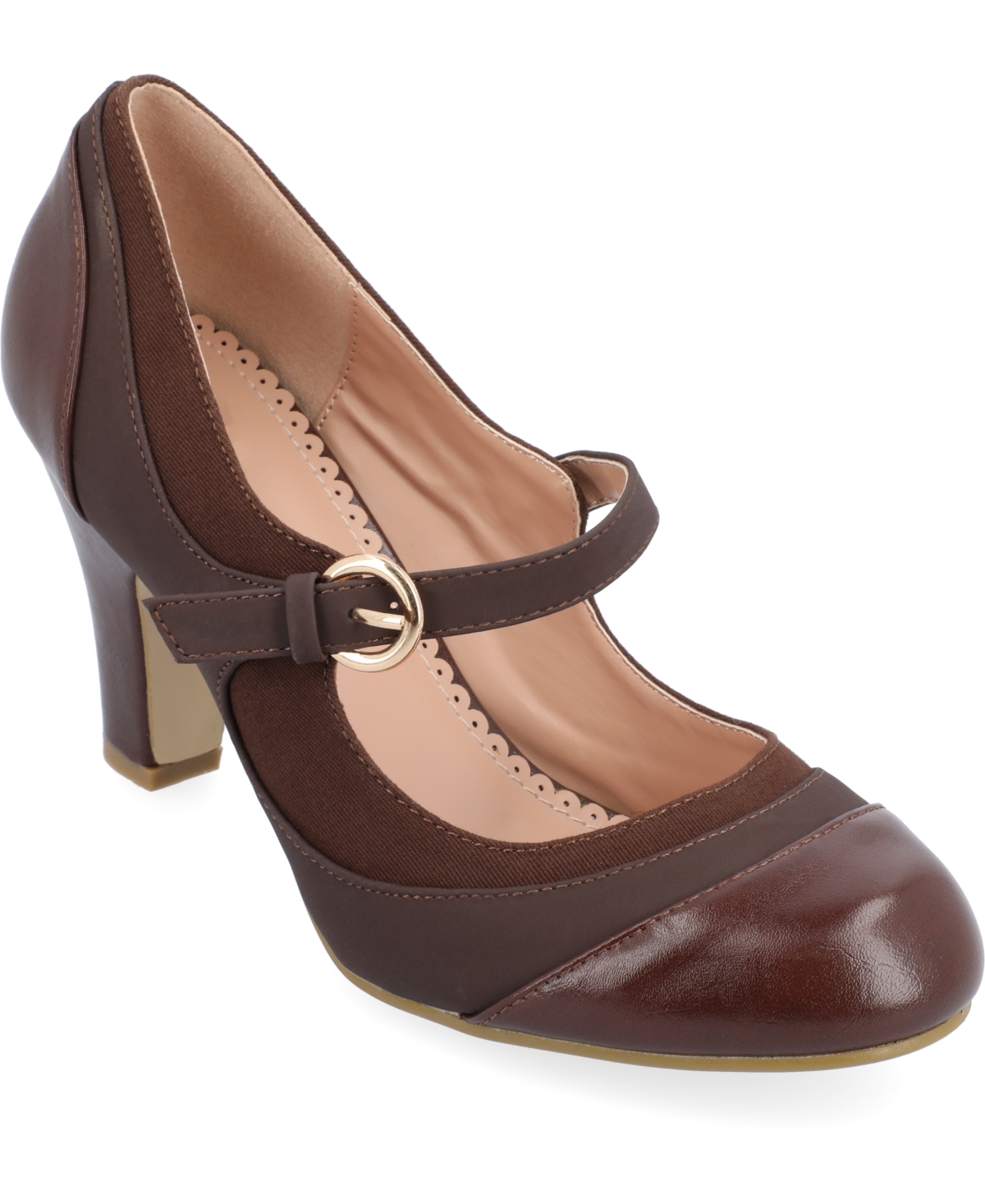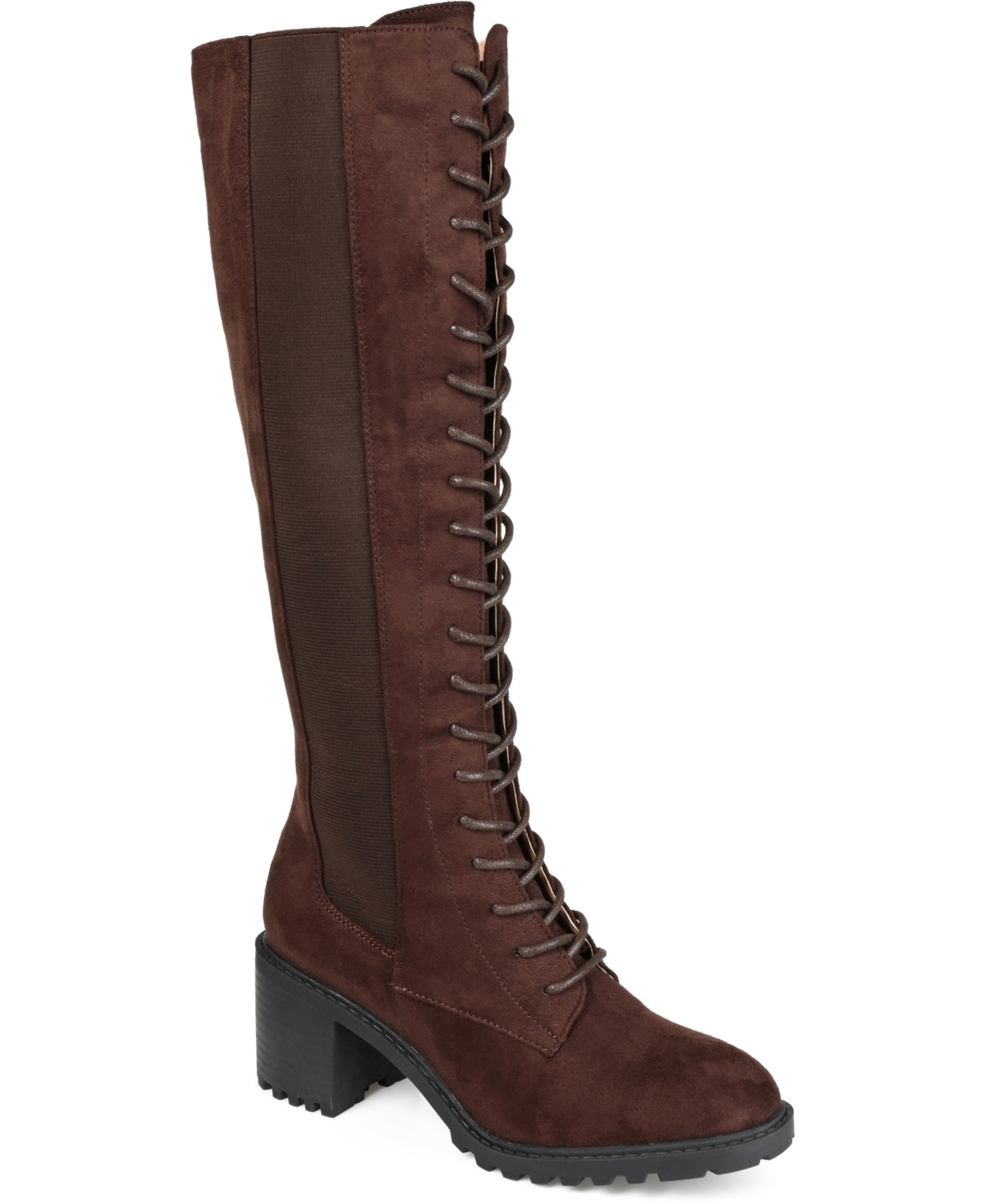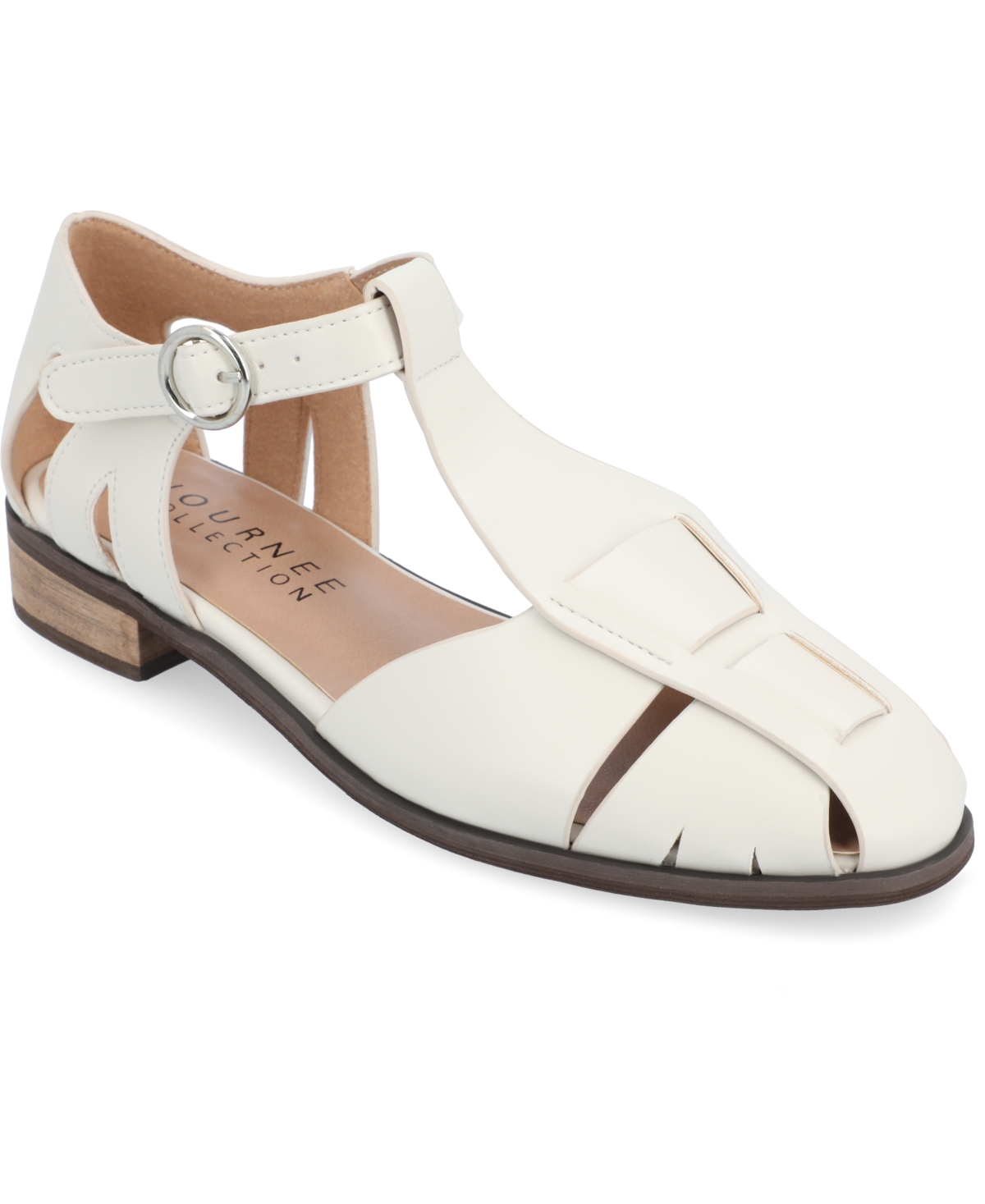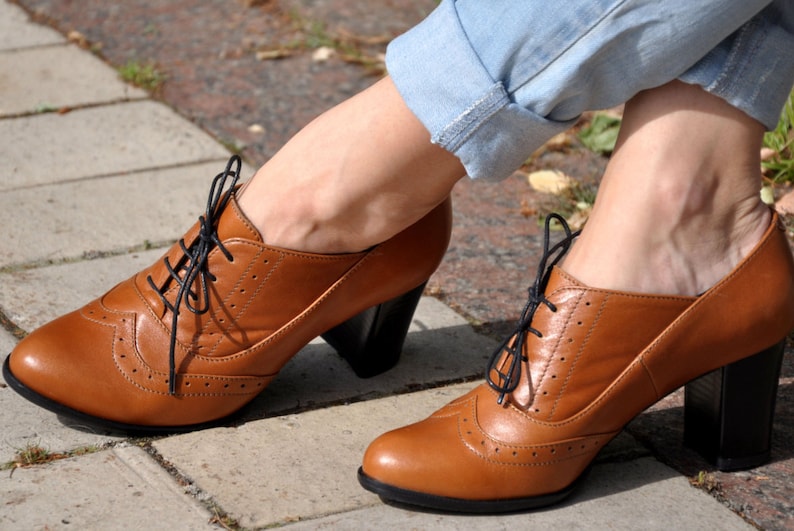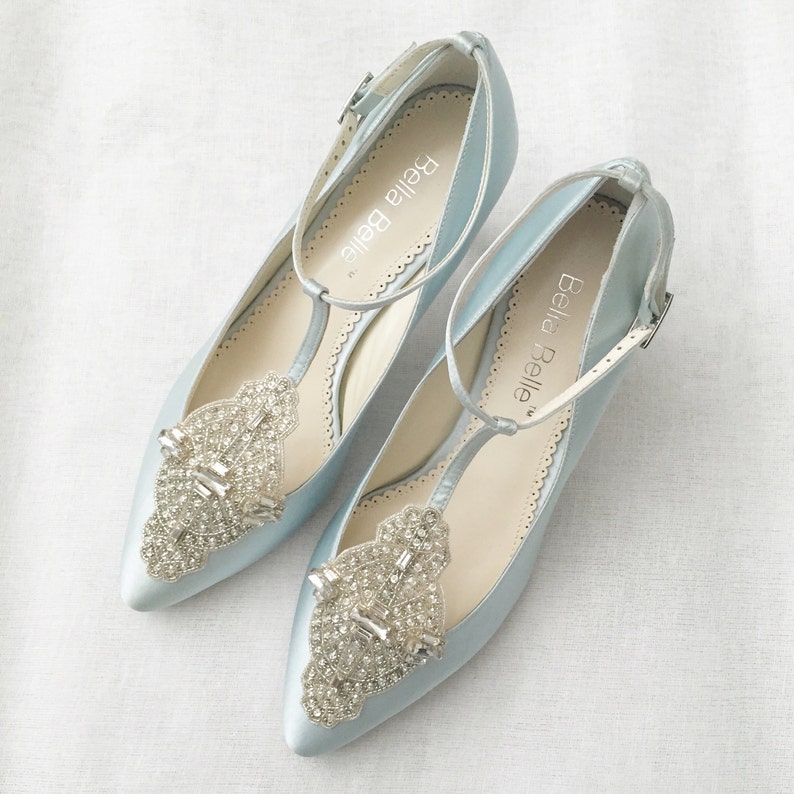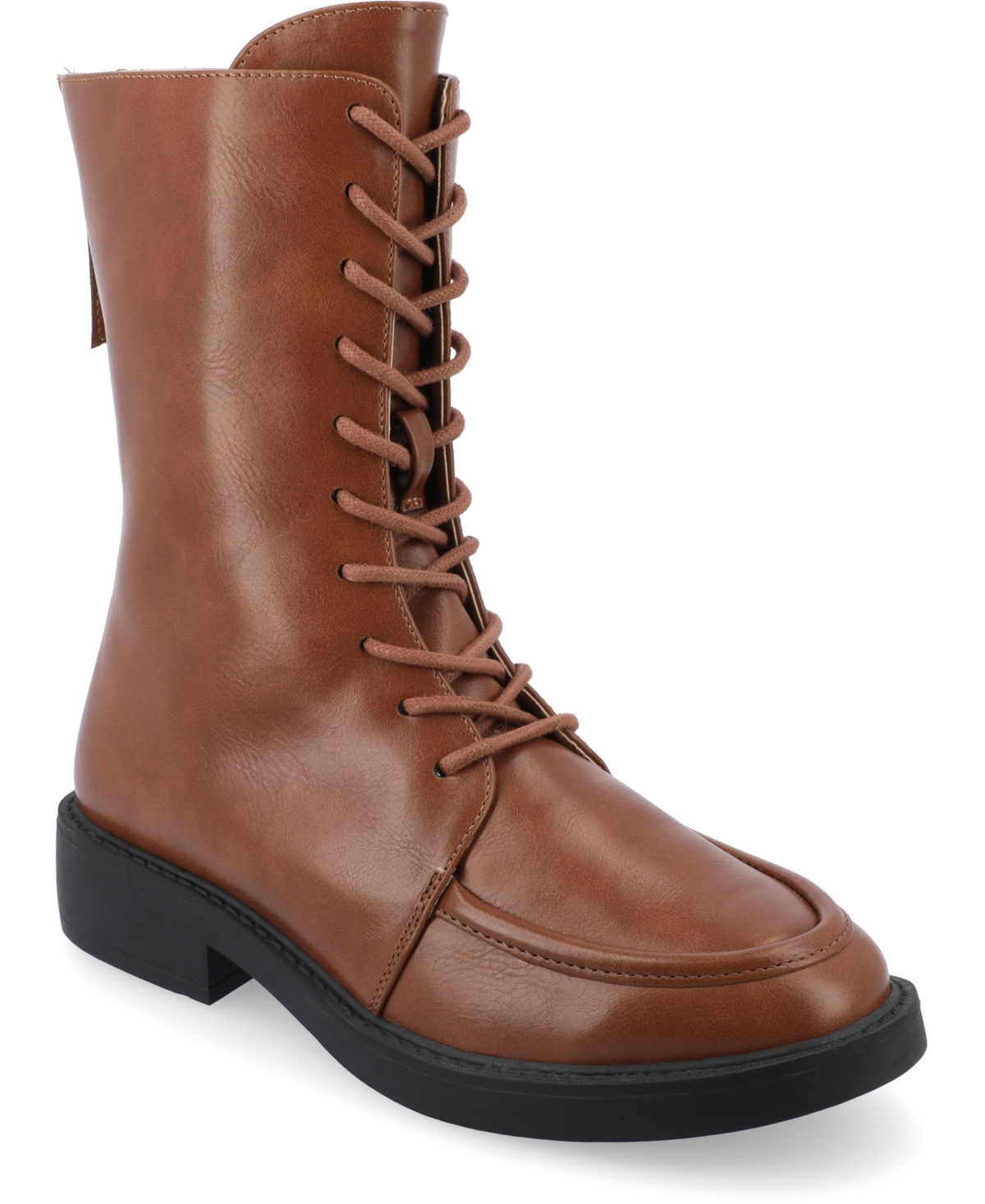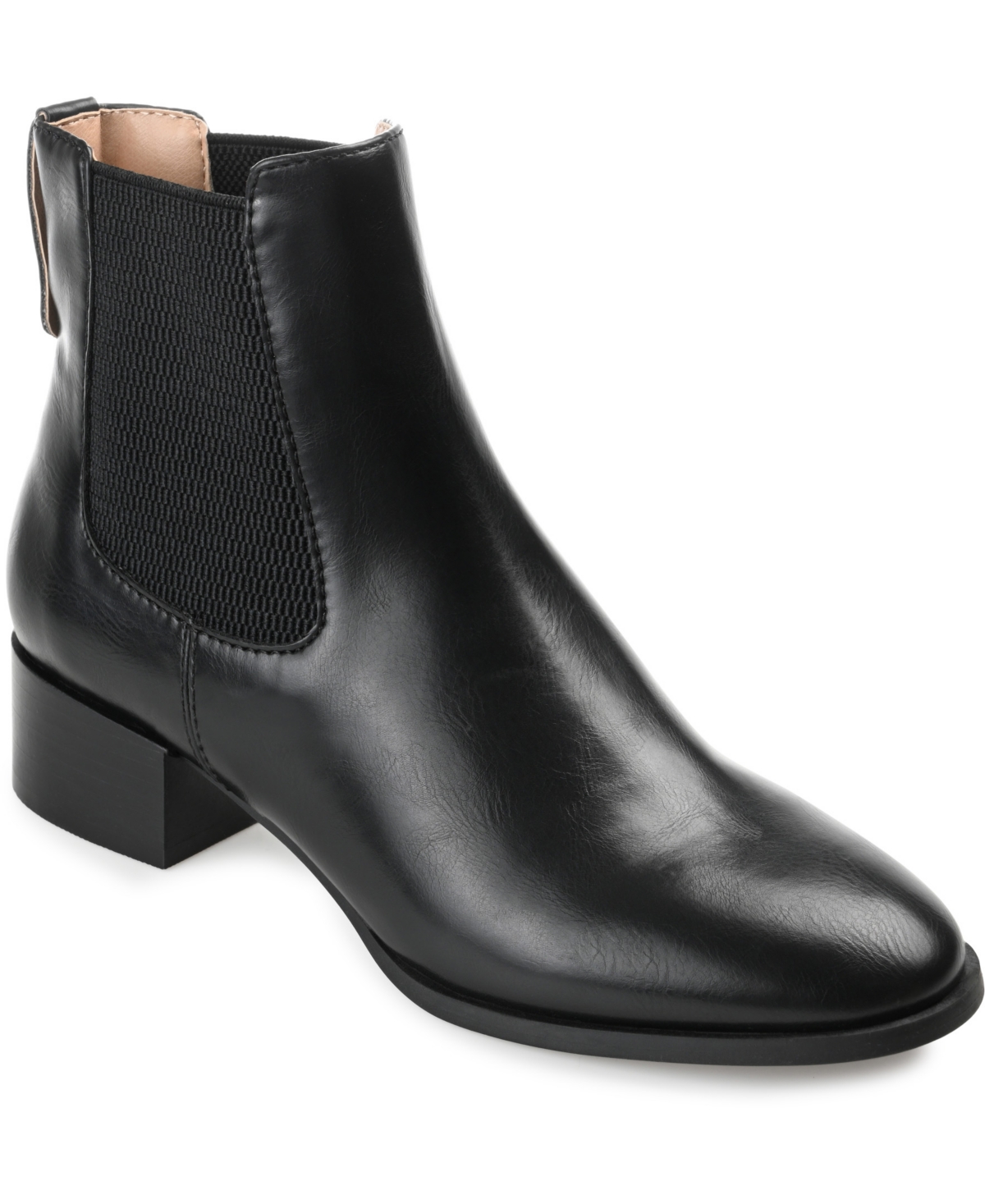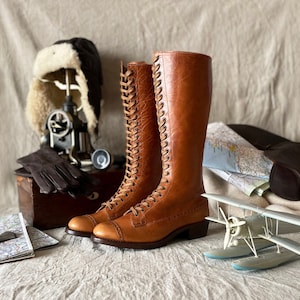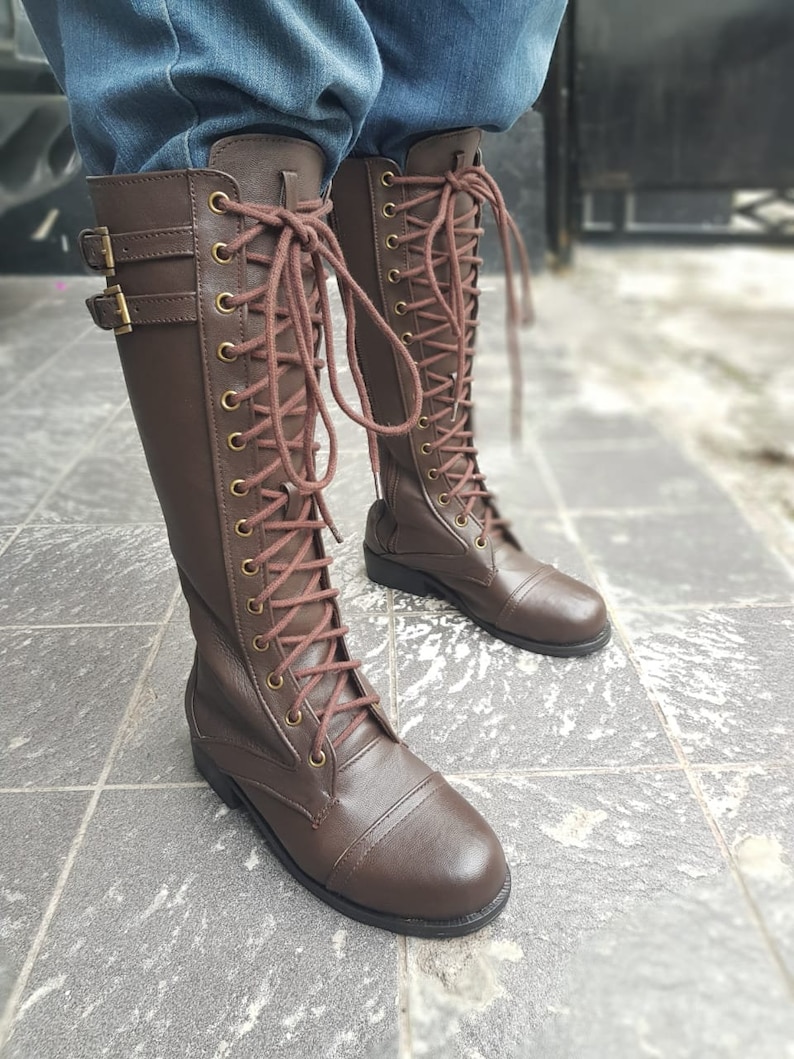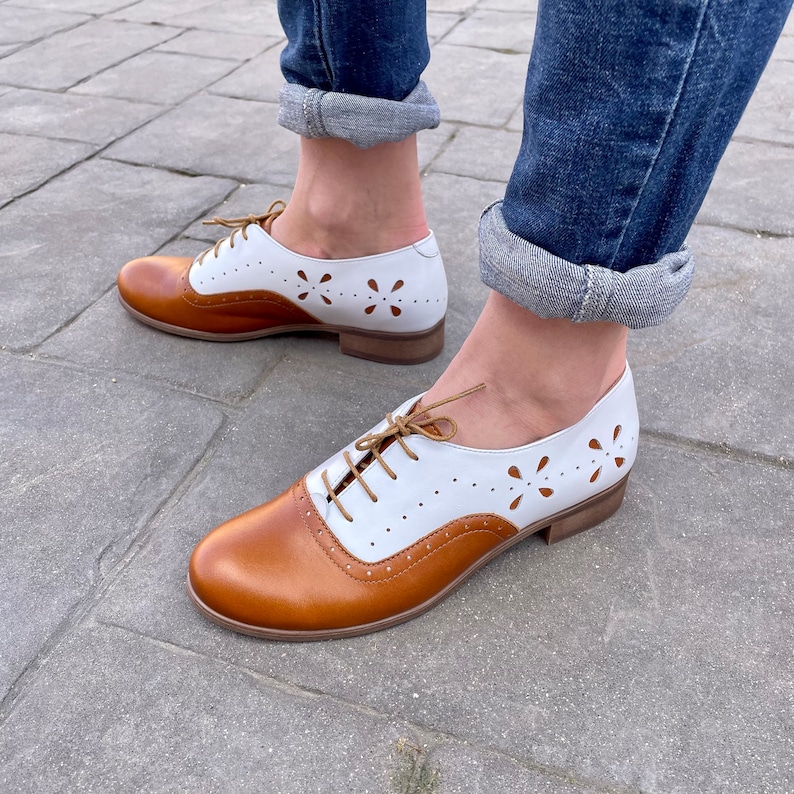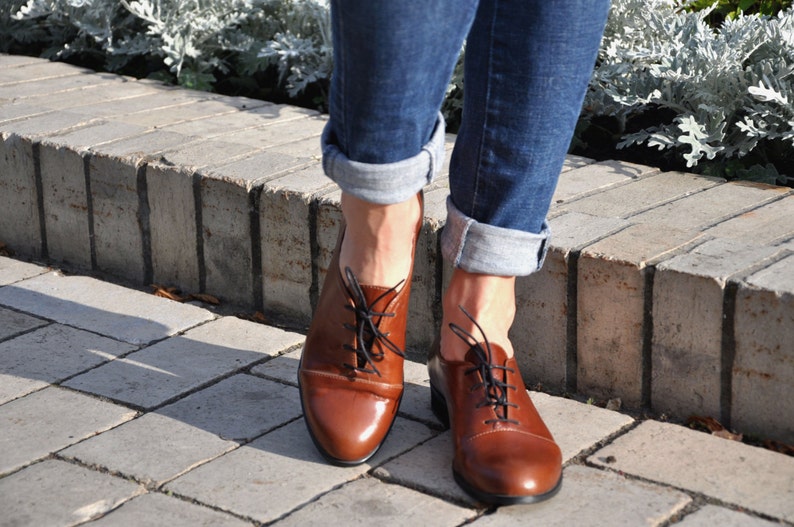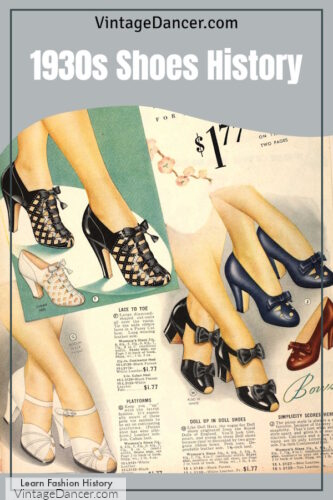
Women of all decades love shoes, and the budget-conscious women of the 1930s were no exception. Smart pairs of stylish 1930s shoes came in a wide array of styles, but certain details made them specific to the “thirties.”
What did shoes look like in the 1930s? Small perforations (holes) in intricate designs on the body of the shoe are a trademark of 1930s shoes, as well as thick straps, full coverage, and lace-up mid-heel Oxfords.
Emphasis was on comfort and durability of 1930s shoes as well as price during this Depression era, yet in the evenings, Old Hollywood glamour inspired an elegant range of dancing heels.
1930s Shoes in Detail
Women’s shoes in the 1930s were all high heels, and even sport shoes had a small flat heel. Cuban heels, Spanish heels, military heels, and built up heels were typical of the 1930s.
Usually made of wood, these square heel shapes with a straight breast (inside the heel) and a curved backside graced the feet of thirties women.
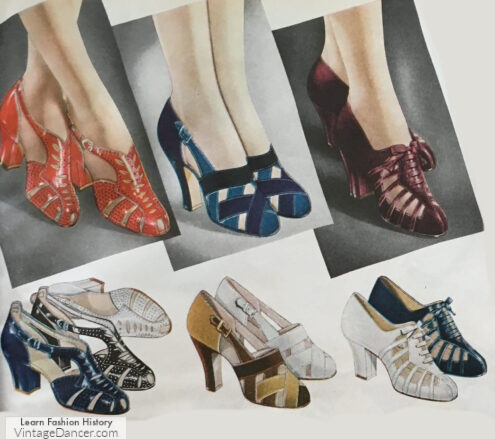
1938 heels – high and mid sizes
Heels ranged in height, 1.5 to 2.5 inches tall. Shorter heels for work, sport, and more casual looks, higher for afternoon and evening wear. Some sport shoes had a lower (1” or less), smaller square flat heel. Only house slippers and beach sandals had flat soles, and even those usually had a small heel.
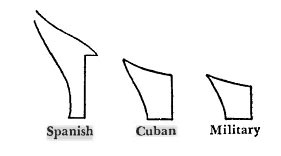
1930s Shoe Heels: Spanish, Cuban, Military
Oxfords and T-straps were popular in the ’20s, ’30s, ’40s and even now, but in the 1930s they explored a creative array of decorative perforations (called broguing), die-cuts, and cut-outs. The cut-outs revealed skin or were lined with a contrasting color or texture of leather or fabric to look like skin.
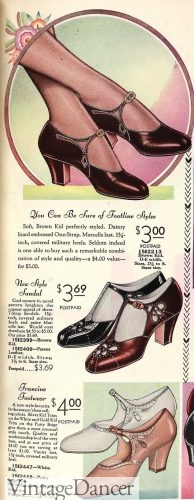
1931 T Strap and Mary Jane (one strap) shoes
Decorative, swirling lines and construction in contrasting colors, reptile skin, suede, or patent leather gave elegance to shoe style. The higher heel on a traditionally low heel Oxford was also a 1930s style contribution.
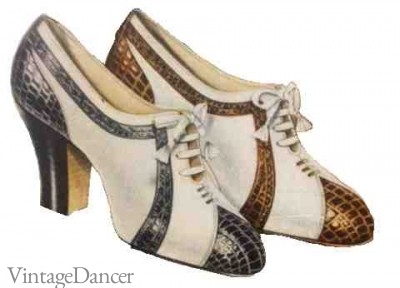
Contrasting Color Reptile Skin Lace-Ups Oxfords
Two-tone shoes were favorites in all shoe styles, as was multiple piece construction on the upper portion, creating interesting seams and an opportunity for contrasting colors and textures.
The toes of women’s shoes were rounded for most of the decade, with a square toe emerging in the late 1930s.
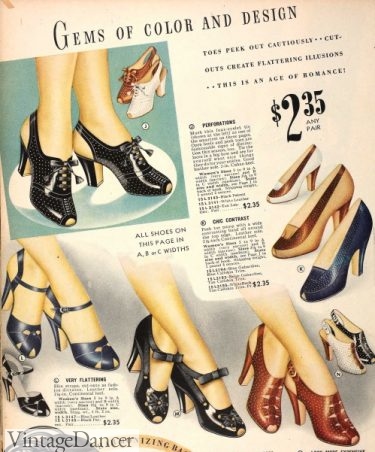
1939 heels
What are 1930s shoes called? Some common shoe styles were called walking oxfords, spectator heels, sandal heels, T strap shoes, dancing shoes, ghillies, saddle shoes, boots and more.
1930s Oxfords Shoes

1930s Oxford shoes
Oxfords and lace-ups, or tie shoes, have been popular for decades: classic, comfortable and chic, thirties Oxfords boasted, of course, lots of cute, creative cutouts, 2-tone styling, and contrasting colors either light/dark brown, white/black, or white with other colors.
- 1937 Medium and low heel oxfords
- 1938 wide fit oxfords
What colors were women’s 1930s shoes? Dark colors were practical year round. Improvements in leather tanning increase the range of browns from deep chocolate or light tan. Suede leather was even more popular than smooth leather, especially with accents of shiny patent leather. White was the best choice for spring and summer Oxfords.
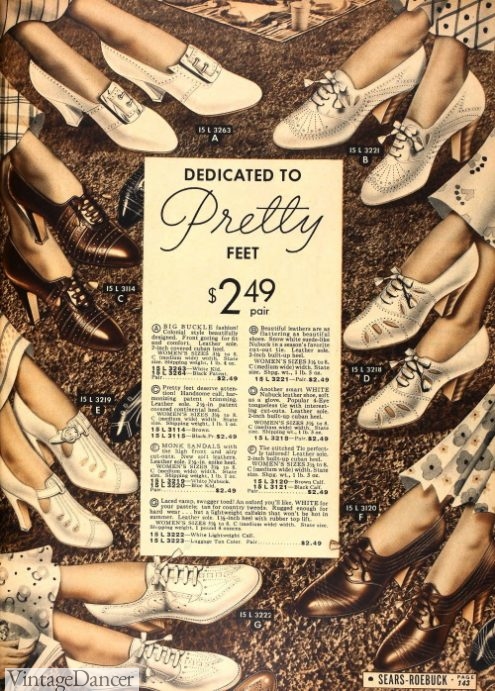
1936 white oxfords and heels for summer
Most Oxfords had lace that tied in a small bow. Others had buckles (usually faux buckles) or simply slipped on. Heels heights ranged from 1 1/2 inches to 2 inches.
Oxfords with scant 1 inch heels were almost flats. These sporty oxfords were popular with athletes, housewives and college students.
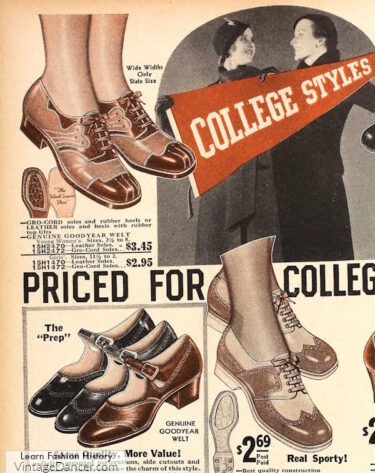
1932 almost flat oxfords and one strap shoes for college girls
The two tone 1930s saddle oxford was also a fashionable trend for college girls and teens. Brown and white or solid brown and black was preferred over black and white which would become associated with the 1950s teenagers.
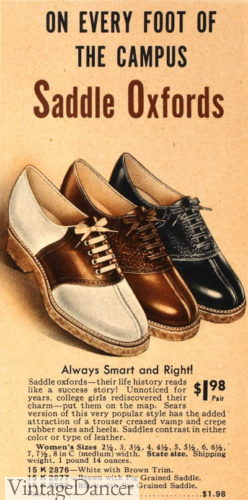
1938 saddle oxfords
1930s Monk Strap Shoes
Monk strap shoes were a one-strap 1930s shoe with an extra wide strap across the middle of the instep, a tall vamp and tongue fully covering the top of the foot. The Monk strap buckled on the side.
Monk straps were the most common Oxford shoe, with multiple piece construction and lots of perforations.
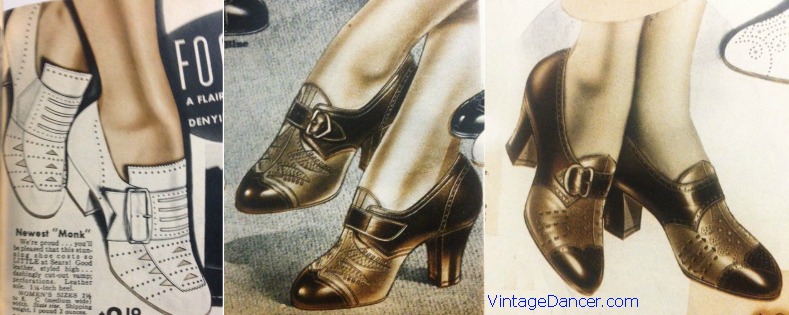
1930s Monk Strap Shoes
Decorative Tongues – Kilties
1930s shoes featuring removable fringe tongues, called kiltie oxfords, gave the wearer two shoes for the price of one! While usually part of a lace up Oxford shoe, the versatility was popular enough there were even sandals and monk strap shoes came with removable decorative tongues.
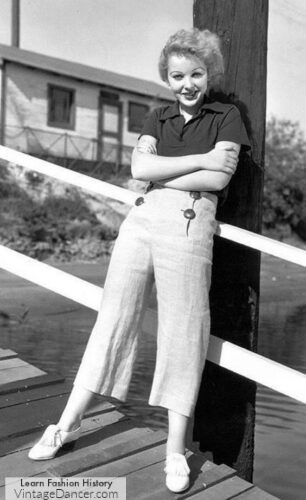
Wearing kilties shoes with a summer outfit
Some shoes came with two tongues, giving the owner three different looks. The tongues were secured with either a bow toe or a small buckle strap. If removed the shoes would look like a lace up oxford.
The 1930s kilties oxford shoe was a casual choice for summer outfits in white or a good suit in fall/winter in dark brown or black.
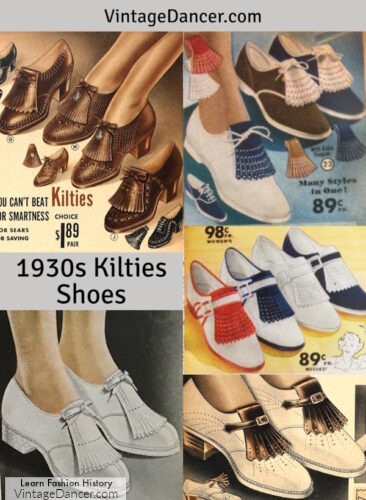
1930s Kilties oxford shoes
Tongued 1930s shoes were practical and frugal– a perfect choice for cash strapped women.
1930s Shoes: Heels
The slip on pump or just “Heels” , just like today, is a classic 1930s shoe.
Pumps
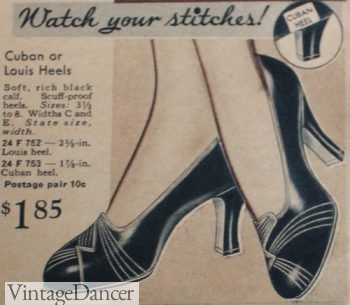
1933 Pumps
With leather being too costly for most women, shoe designers turned to other skins such as lizard, crocodile, and snakeskin. The texture of these skins provided a new look to the dainty shoe.
Evening heels came in rich silky fabrics such as satin, patent leather, velvet and brocade.
Most pumps were plain colors and were sold with an option of a low Cuban heel or taller Louis heel for evenings. Some fancy styles had contrast stitching, swirls, applique Art Deco shapes, and clip on bows.
- 1931 satin moire pumps
- 1935 white bow pumps
- 1935 classic black pumps
- 1936 white summer pumps
1930s T-strap / T-bar shoes
The T-strap heel was super popular in the 1920s and persisted into the 1930s, but with lots of quintessentially ’30s perforations and cut-outs.
T-strap sandals were great for summer, and white was the most popular summer shoe color, although bright colors and some pastels were worn as well.
Black T-straps remained the ideal versatile day or evening shoe for most of the early to mid 1930s.
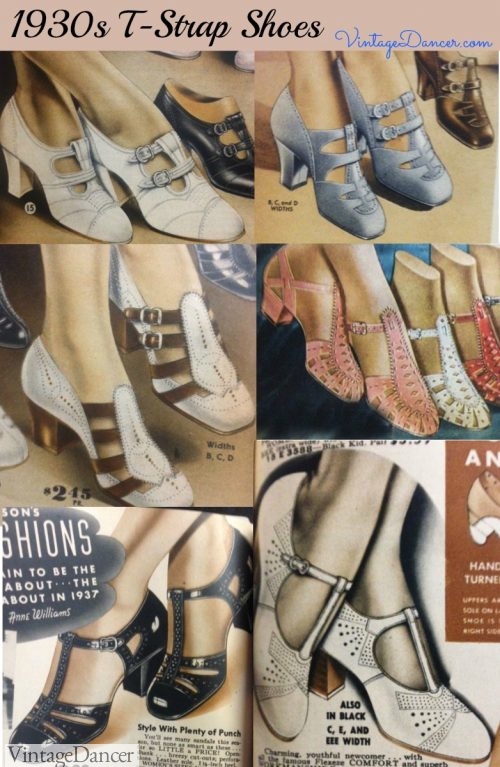
1930s T Strap Shoes: Single, Two strap, Multi strap
1930s T-strap shoes in the early years were thin and delicate with small silver buckles. Casual heels had wider straps and often added other cross straps to the design. The more straps the better! This style mimicked the look of cutouts.
One-strap shoes – Instead of a T-strap, wear a one strap! Simple and elegant skinny one-straps secured the shoe high on the instep, once again on a shoe full of delicate cut-outs, and contrasting colors. One-strap shoes are often called Mary Janes today.
The 1930s mary jane shoe was common in the early 1930s, having been the ultimate ladies shoes to wear in the 1920s. However by 1934 the one strap shoe was almost gone being replaced by the T Stap, the fancy oxford or slip-on pumps.
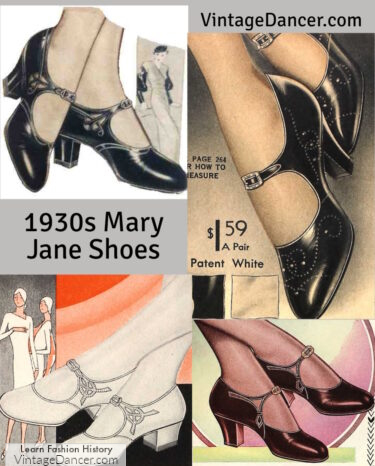
1930s mary jane shoes
1930s Sandals
Dressy sandal heels came in an assortment of breathable styles, such as slingbacks, high-heels, open toe, wedge, platforms, or a combination of these styles into one shoe.
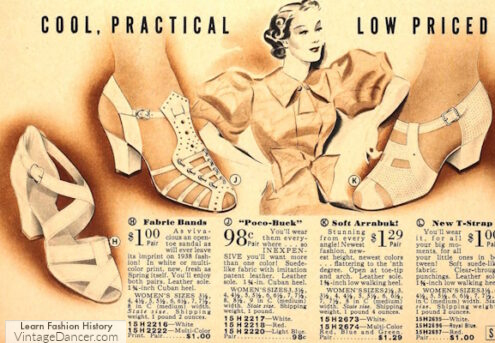
1938 white sandal heels
White was the most popular 1930s sandal color. Most sandals had a good 1.5 to 2 inch Cuban heel.
Toward the latter half of the decade, empire sandals were the new hot trend for spring and summer. A high front shoe with deep cutouts at the arch of the foot and secured by one strap high on the instep, it came in white, solid colors and the thirties favorite: 2-tones in a summery array of colors.
- 1937 mixing color sandals
- 1937 sandals in new colors
- 1937 strappy colorful sandals
- Sandals -1938 (Espadrille in Center)
Espadrille and Huaraches Sandals
The woven straw sandal was inspired by the Mexican Huarache shoes that were selling like mad in the mid-1930s around LA beaches.
These open weave straw or braided leather summer sandals replaced the lace-up beach style of the 1920s. They were flat on the bottom or with a 1 inch heel to protect feet from hot sand yet exotic looking to the city tourist.
- 1930 brown huarache sandals
- 1931 braided leather huarache sandals
Another summer shoe trend, escpailly at the end of the decade was for Espadrille style sandals with long laces that tied up the ankle like ghillies. The long laces were replaced by a strap and buckle going into the 1940s.
Many espadrilles were made of cotton canvas in striped “awning” prints. Other were crochet or knit yarn and even straw. They were every colorful and very fun to be worn barefoot or with socks.
The soles were made of polished wood or thin rubber. Some were flats while other had a 1/2 inch heel for just a bit of lift.
- 1937 espadrille sandals
- 1939 espadrille sandals
Vintage Dunlop beach sandals – Wow, real vintage shoes with box and a photo of a woman wearing them
Re-created crochet sandals from a vintage pattern – These are sooo cute!
Ghillie Laces
Another trendy 1930s sandal was one with Ghillie laces. Ghillie lacing usually threaded through flat loops of the upper shoe material instead of eyelets, with the lacing points set wide across the instep to feature the criss-cross design.
Like most 1930s fashion shoes, Ghillie laced shoes were graced with lots of brogues, came in two tones or came with a removable tongue. Some of the lacing designs found their way onto Oxfords too.
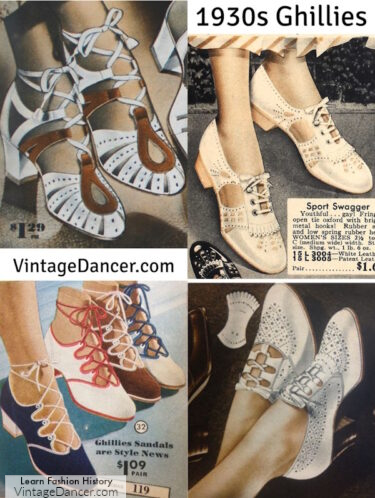
1930s ghillies sandals and oxfords
1930s Casual Shoes
The 1920s started the trend for the canvas saddle shoes– a two-tone low heel Oxford with a contrasting panel of color in the center.
The 1930s saddle shoe expanded the low heel style into a mid heel walking Oxford. The colorful oxford was the most casual 1930s shoes for women and men.
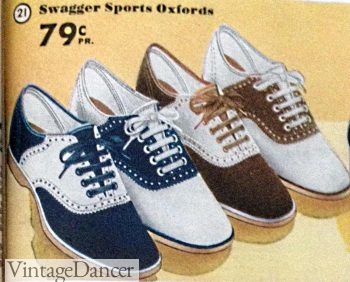
1937 Saddle Shoes
Color choices grew, too. Instead of just brown and white, oxfords came in blue and white, tan and white, black and white, or green and white. The body could be white or colored with contrasting laces.
The Crepe rubber sole replaced expensive leather and was durable, non-slip, shock absorbing and less costly to make and buy.
Read more about the history of saddle shoes, including more details on the 1930s styles.
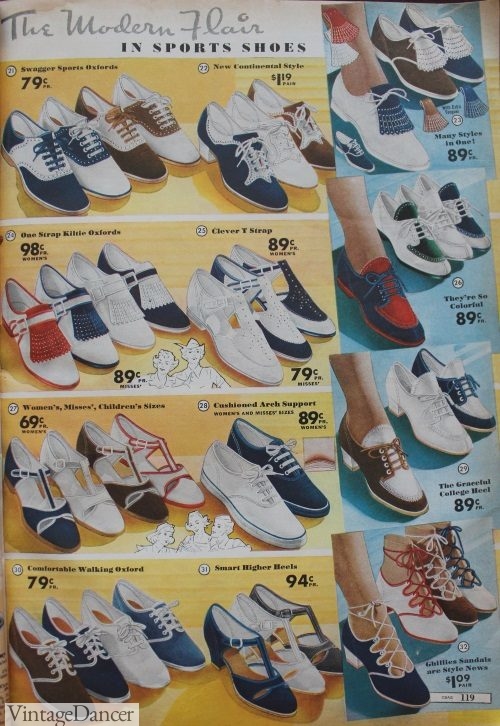
1937 Sport Shoes- Two Tones in All Styles
1930s casual shoes were called sport shoes. Many sport shoe styles featured the two-tone pattern: two-tone sandals, low T-strap heels, flat sneakers, Ghillies, and moc toe oxfords with a very low, almost flat .5 inch heels. They also came in solid colors with contrasting edging – navy blue, copen blue, red and even polka dots!
Classic sport shoes are still being worn today — we know them as Champion Original Keds sneakers. They have flat rubber soles and a low profile canvas body with matching or contrasting laces.
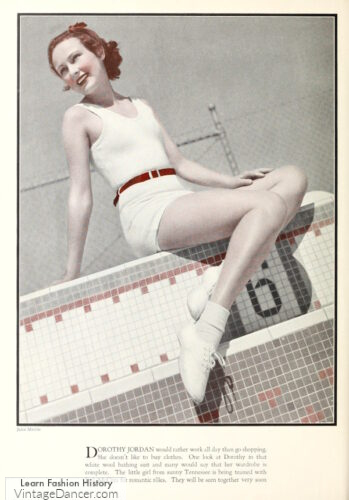
1933 Dorothy Jordan models white sneakers and cuffed socks with her swimsuit
In the 1930s sneakers, called tennis shoes, usually came in white, black, or brown, sometimes with a rubber cap toe. 1930s women’s sneakers were worn as sportswear or casual footwear, often with cuffed socks.
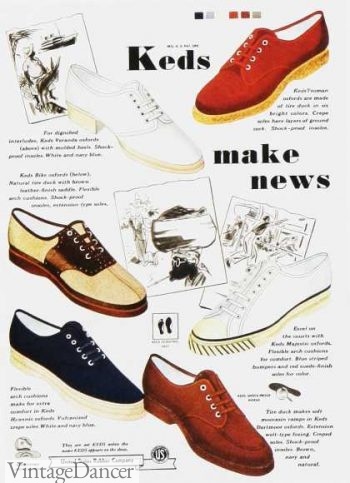
1930s Keds Sport Shoes
The 1930s high top sneaker, known today as Converse today, was mostly worn by young men for athletics, but young women could wear them, too, in white, tan or two-tone black and white patterns. The high top design has changed little since their invention at the turn of the century.
Read more about the history of women’s sneakers.
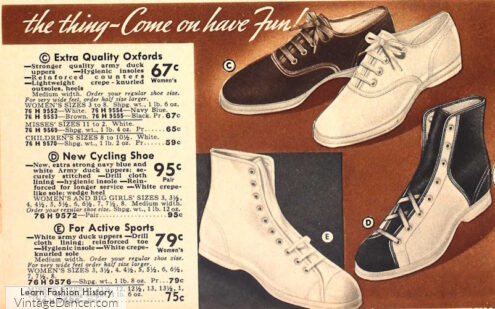
1938 high and low top sneakers / tennis shoes
A third sports shoe was the canvas sandal with a single Mary Jane or T-strap. These were common summer shoes and more affordable than straw flats.
They were designed to be worn barefoot hence the name “barefoot sandal” to the beach or pool or everyday summer activities. While most were made of cotton canvas in white, brown, or two-tone blue and white, some were made of leather. Smoke grey was a trendy color for leather sandals.
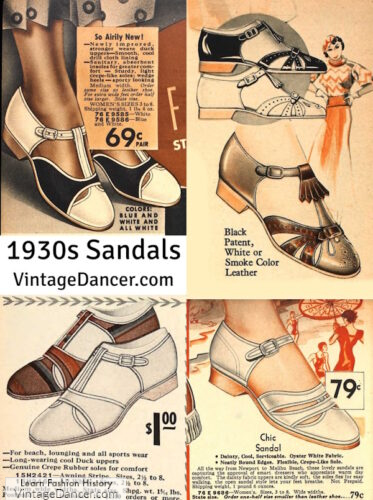
1930s Beach Sandals
Read more about the history of women’s vintage sandals.
1930s Evening Shoes
Evening time was a chance to shine in glamorous Hollywood-inspired gowns with matching satin heels. Evening shoes had a higher Louis heel, 1.5 to 3 inch, leather soles. They were called dancing shoes, perhaps because the only time they were seen was while dancing on the ballroom floor.
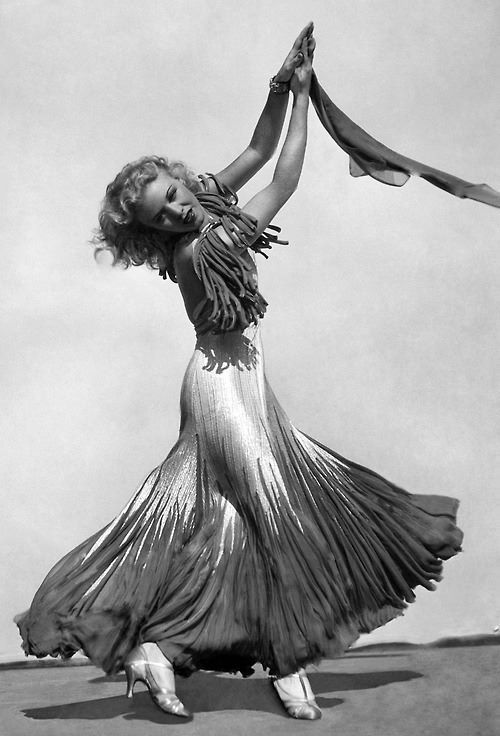
Ginger Rogers Dancing in T-Strap Silver Shoes
Black patent leather was the most versatile, but silver was the best. Gold, bronze, or ivory white were other shimmery metallic colors. Some were embellished with beadwork or embroidery in the early years, while Art Deco-inspired trim found their way onto heels in the late 1930s. Cutouts of silver or gold, zig zags, or swirls were stitched on rich fabrics of crepe, suede or velvet. The look was festive yet restrained, lady like yet comfortable.
- 1938 cross strap evening heels
- 1938 silver and black T Strap evening shoes
Evening shoes could be pump style, but they were not the best for dancing. Instead, women wore strappy dancing sandals. The 1920s style T-strap shoe was still the preferred evening style, especially with high heels. Toes were pointed but rounded out somewhat by the 1940s. Open toe shoes were called “barefoot sandals”, ideally showing off a new fad for painted toenails. A latticework of straps secured the shoe yet revealed the foot like never before.
- 1938 cross strap patent leather evening sandals with matching purse
- Ankle strap evening heels
Toes were now beautiful. Heels were not. Most stockings had reinforced heels so the slingback shoe was not glamorous. They were still worn but only with long gowns that covered the heel.
1930s Boots
Some older women continued to wear lace up mid calf boots just like they had for most of their lives. Fashionable women didn’t wear boots for day to day life. The exception was in winter when rain, mud, and snow destroyed nice heels.
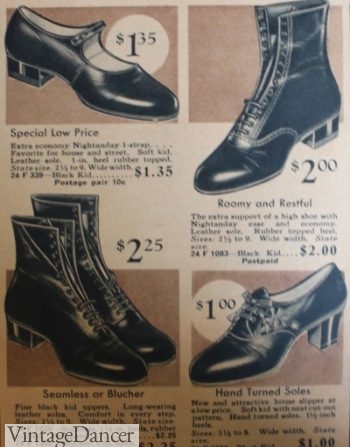
1933 Lace up Granny Boots and Low Heels Shoes
Women protected their shoes with overshoes made of rubber. They were worn over heels. Shearling lined snow boots were another option that had women carrying their nice shoes with them to change into once inside. Read more about rubber overshoes and snow boots.
- 1938 snap-on scallop edge rain rubber boots
- 1938 snow boots
For some sports like horseback riding or hiking, tall over the calf lace-up boots were worn. Shorter ankle boots and even lower Oxfords made of sturdy leather were options for light-duty sports.
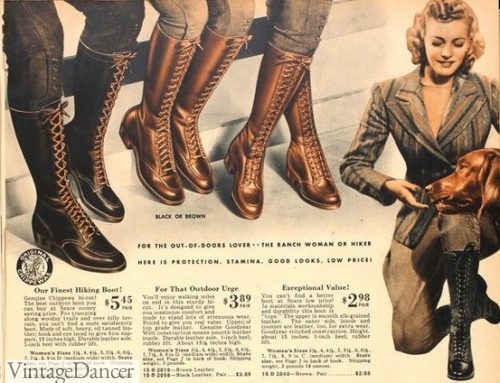
1930s “For the out-of-doors lover.. The Ranch woman or hiker.”
1930 Style Shoes Today
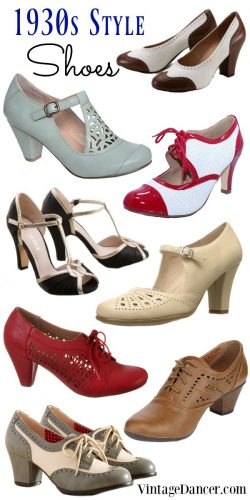
1930s style shoes
The 1930s set the tone for vintage shoe styles for the next 30 years and more. Oxfords, sandals, T Strap and Mary Janes all continued into 1940s and 1950s fashion. I look for shoes with cutouts, broguing (small holes), sandals, and T-straps in white, black patent, two-tone, or metallic colors. While flats were rare in the 1930s, many of details found on 1930s heels, such as brogue or multiple straps, will look vintage enough as flats.
Many of the ’30s styles are still popular today although with a modern spin on them. Check out my handpicked section of new 1930s style shoes for sale here.
For vintage 1930s shoes, search Etsy or eBay. Keep in mind that most vintage shoes run narrow. Ordering a half to whole size up with help you fit vintage shoes better.
